Vol. 70, No. 5 (2021)
2021-03-05
INVITED REVIEW
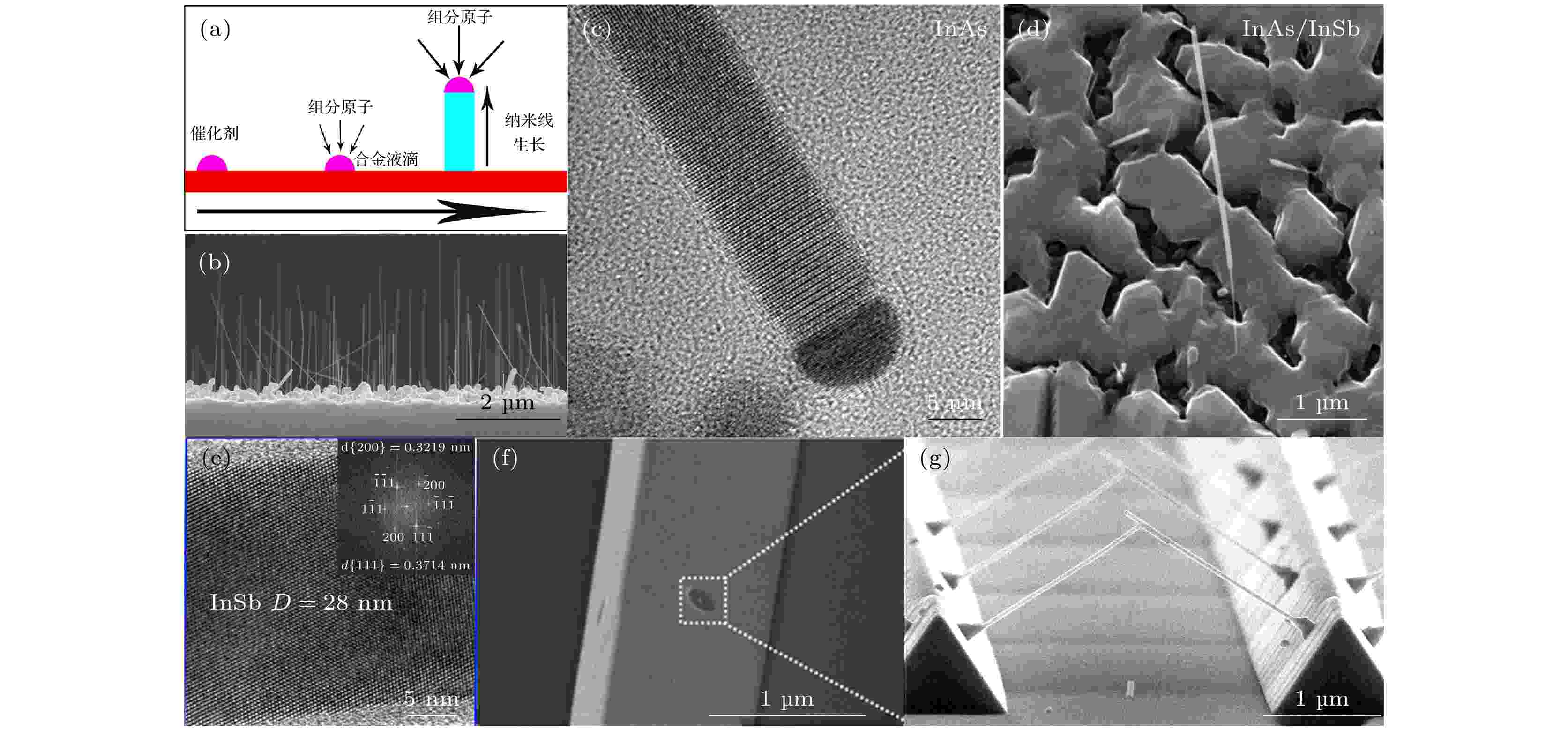
INVITED REVIEW
2021, 70 (5): 058101.
doi:10.7498/aps.70.20201750
Abstract +
As the version of Majorana fermions in condensed matter physics, the research of Majorana zero modes is one of the most interesting topics in physics currently. Majorana zero modes obey the non-Abelian statistics and can be used for constructing the topologically protected qubits. This kind of qubit constructed from spatially separated Majorana zero modes is immune to local noise, and has a long decoherence time, which makes it show important application prospects in fault-tolerant quantum computation. The semiconductor/superconductor nanowires are one of the most ideal experimental platforms for studying Majorana zero modes and topological quantum computation. This work reviews the research progress of the epitaxial growth of high-quality semiconductor nanowires, the fabrication of semiconductor/superconductor heterostructure nanowires, and Majorana zero modes in semiconductor/superconductor nanowires. The application prospects of semiconductor/ superconductor nanowires in quantum computation is also prospected finally.
REVIEW
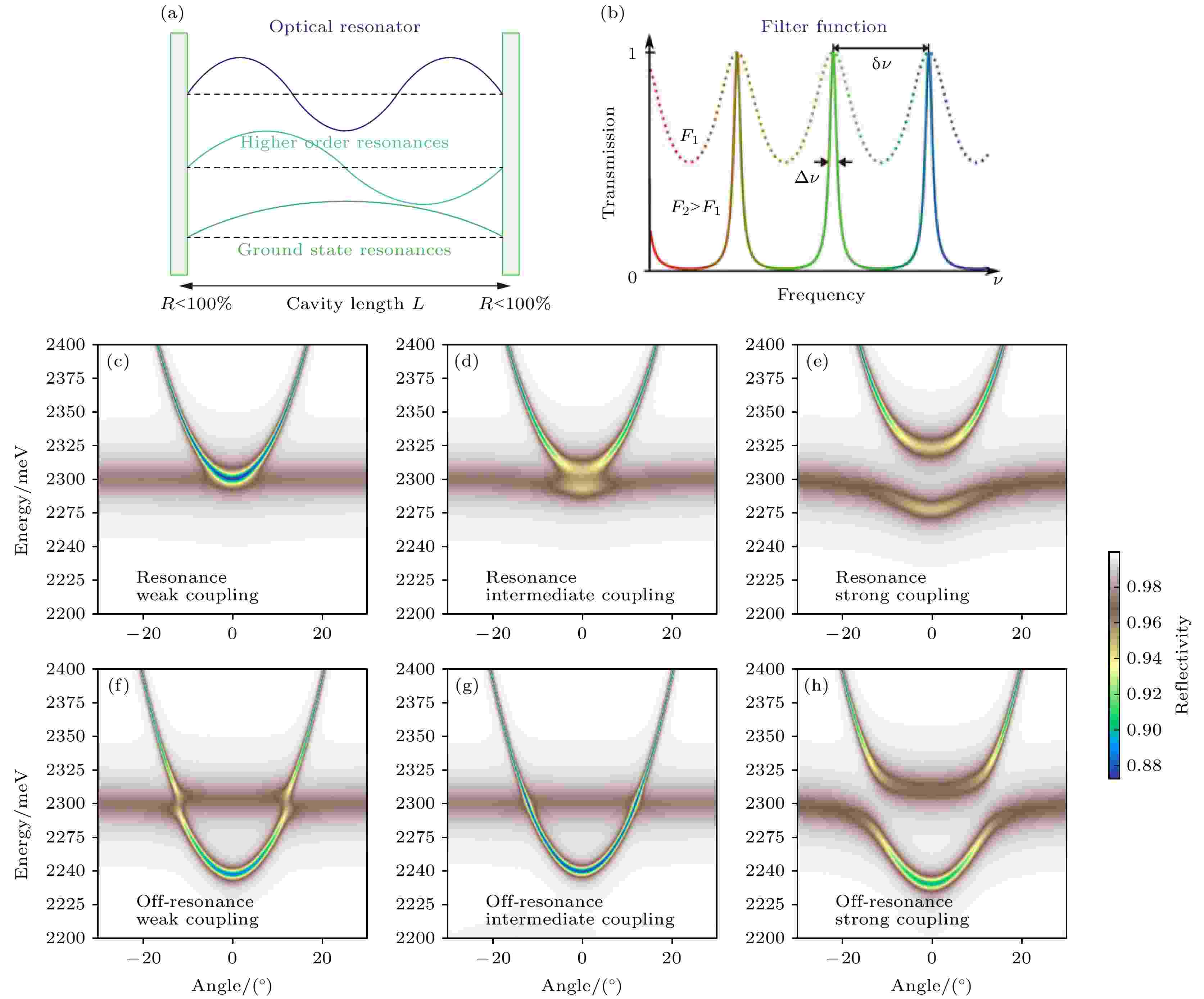
2021, 70 (5): 054205.
doi:10.7498/aps.70.20201302
Abstract +
With the advent of the post-Moore era, the demand for large-capacity and high-speed information processing has caused the application of semiconductor devices to shift from electronic integration to photonic integration. High-performance micro-nano lasers are an important part of achieving photonic integration. Varieties of semiconductor materials have promoted the rapid development of semiconductor micro-nano lasers. In recent years, with the advent of a large number of new semiconductor materials (such as two-dimensional semiconductors, lead halide perovskites, etc.), it is expected that the performances of semiconductor micro-nano lasers will be further improved. Perovskite materials have excellent optical properties such as high light absorptions, high defect tolerances, and large exciton binding energy, whichmakethem excellent candidate materials for high-gain, low-threshold semiconductor micro-nano lasers. The Fabry-Perot (F-P) resonator laser is a type of perovskite laser with extensive research, simple structure and high application value. In this paper, we take lead halide perovskite F-P resonator laser for example, and summarize its working mechanism and recent research results, by starting from two aspects of photon laser with exciton and photon weak coupling and strong coupling polariton laser. And we introduce the lasing principle and influencing factors of F-P structure lasers with perovskite materials as both gain medium and resonant cavity and F-P cavity lasers with perovskite as only gain medium in detail. Finally, the current challenges of perovskite F-P resonant lasers are summarized, and the possible prospects of its further development are also presented.
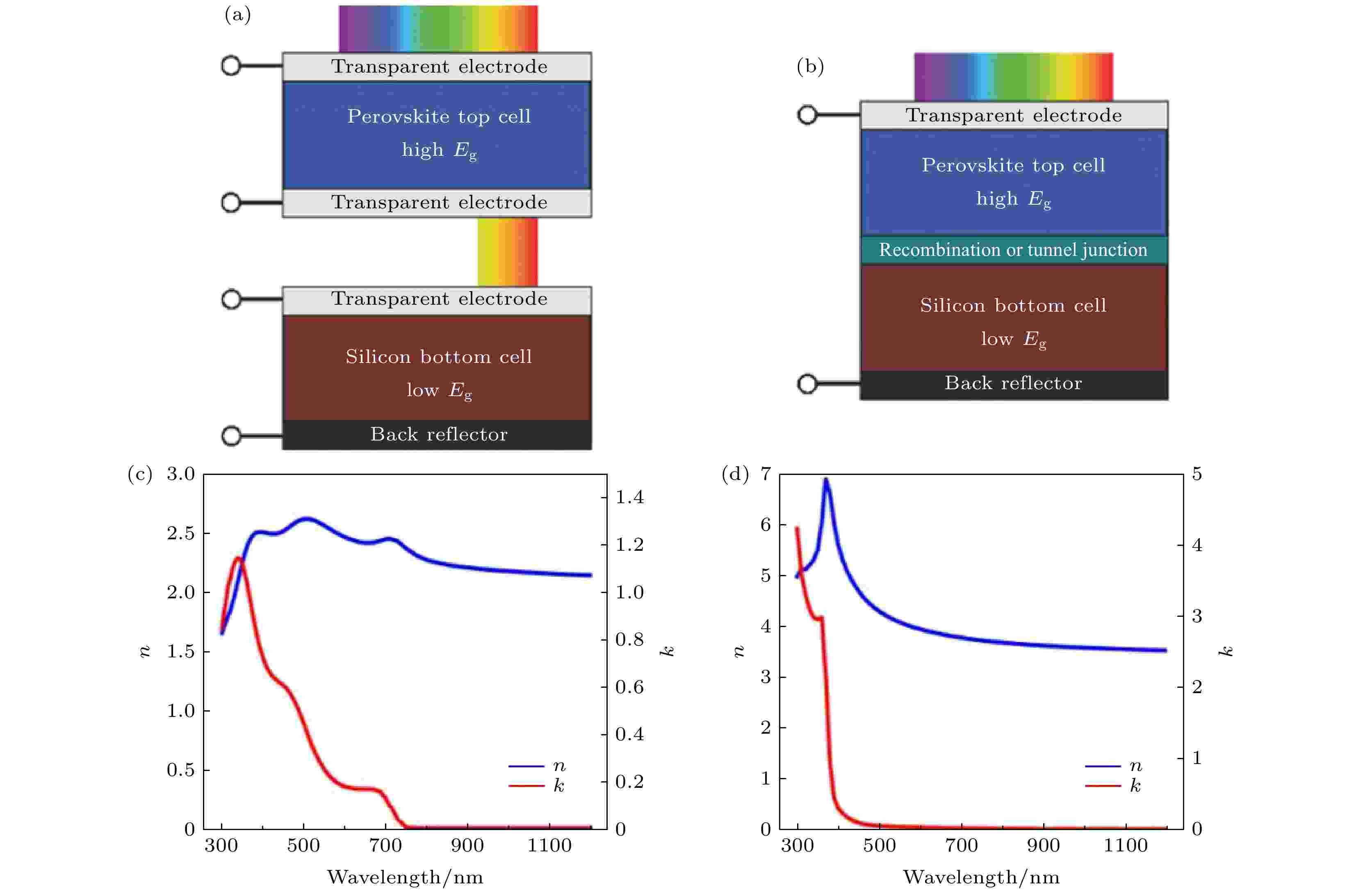
2021, 70 (5): 057802.
doi:10.7498/aps.70.20201585
Abstract +
Perovskite/silicon heterojunction tandem solar cells have developed rapidly in recent years, and their efficiency is enhanced from 13.7% to 29.1%. As is well known, the optical loss has a great influence on the efficiency. Due to the complex fabrication process of tandem solar cells, it is important to obtain high-performance tandems through optical simulation. In this paper, optical simulation methods are mainly summarized from two aspects: commercial software and self-built model. Then, the progress of optical simulation is analyzed in terms of reflection loss and parasitic absorption. Finally, what should be paid more attention to in the optical simulation of tandem solar cells is pointed out. The efficiency limit of perovskite/silicon heterojunction tandem solar cells can reach up to 40%, but there remains much room for improvement. The research on optical simulation will lay the foundation of developing the tandem solar cells.
GENERAL
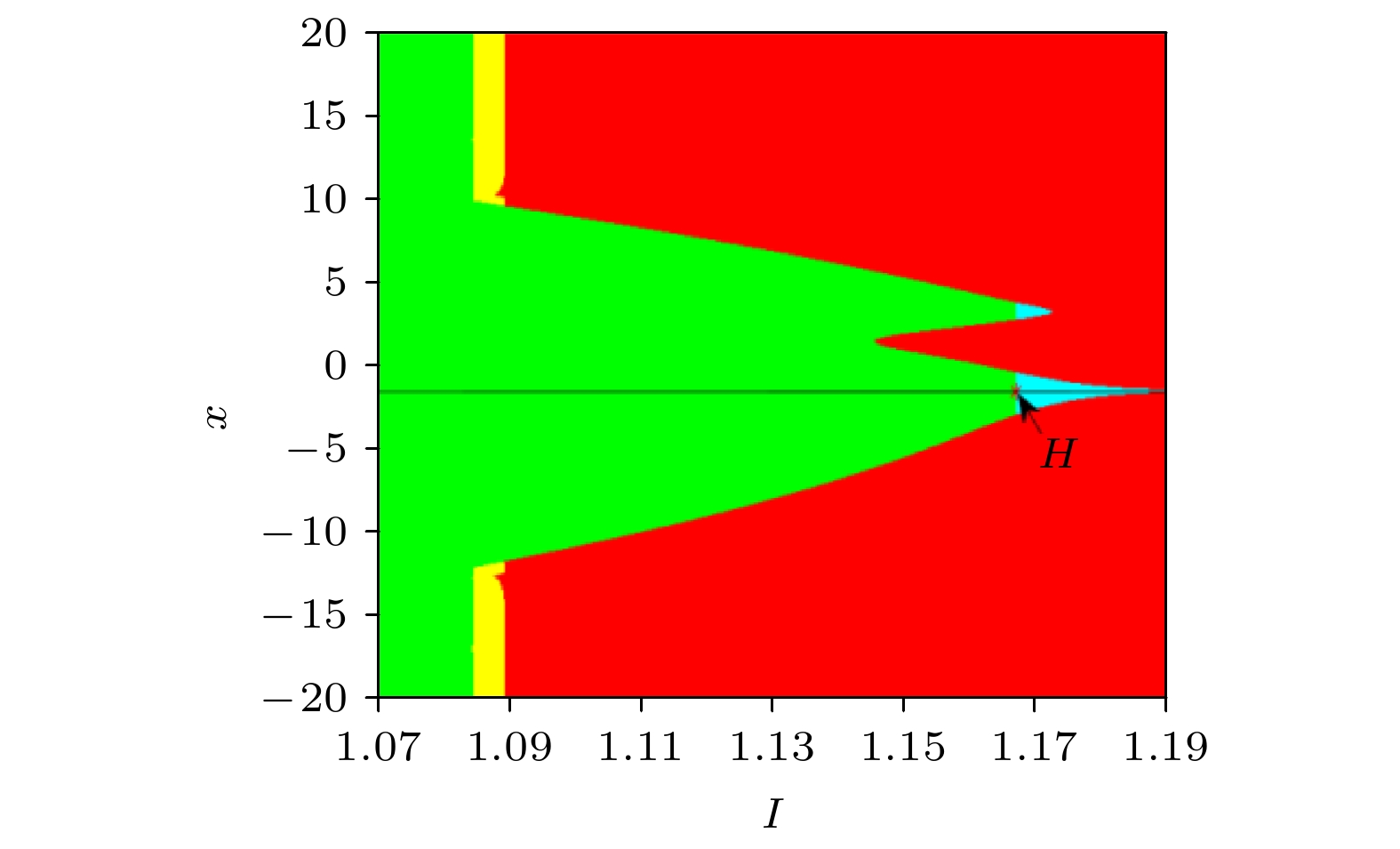
2021, 70 (5): 050501.
doi:10.7498/aps.70.20201347
Abstract +
The time-varying electric fields generated by continuously pumping and transmitting calcium, potassium and sodium ions in cells not only affect the discharge activity of neurons, but also induce time-varying magnetic fields to further regulate the fluctuation of ions. According to the Maxwell's electromagnetic field theory, time-varying electric field and magnetic field can stimulate each other in the electrophysiological environment inside and outside the cells to produce electromagnetic field. In order to explore the discharge rhythm transition of neurons under the influence of electromagnetic fields, a five-dimensional (5D) HR neuron model (EMFN model for short) is established by introducing magnetic flux variable and electric field variable into a three-dimensional (3D) Hindmarsh-Rose (HR) neuron model. Firstly, the equilibrium distribution and global bifurcation properties of EMFN model are analyzed by Matcont software, then the existence of subcritical Hopf bifurcation, hidden discharge, coexistence of periodic discharge and resting state are found and analyzed. Secondly, by using the tools of two-parameter and one-parameter bifurcation, ISI bifurcation and the maximum Lyapunov exponent for numerical simulation, the period-adding bifurcation with and without chaos, mixed mode discharge and coexistence mode discharge in the EMFN model are analyzed in detail. At the same time, the transition law of discharge rhythm with the influence of electric field and magnetic field intensity is revealed. Finally, the Washout controller is used to convert the subcritical Hopf bifurcation into supercritical Hopf bifurcation, so the topological structure of EMFN model near the bifurcation point is changed for eliminating the hidden discharge. The research results of this paper confirm that the novel neuron model has rich discharge rhythm, which will affect the information transmission and coding, and provide some ideas for improving the neuron models, revealing the influence of electromagnetic field on biological nervous system, and exploring the pathogenic mechanism of some neurological diseases.

2021, 70 (5): 050502.
doi:10.7498/aps.70.20201249
Abstract +
Boolean networks (BNs) are nonlinear systems and each BN has a simple structure, thus it is easy to construct large networks. The BNs are becoming increasingly important as they have been widely used in many fields like random number generation, gene regulation, and reservoir computing. In recent years, autonomous Boolean networks (ABNs) have been proposed and realized by actual digital logic circuit. The BNs each have a clock or selection device to determine the update time of each node. Unlike BNs, ABNs have no device to control the update mechanism, and the update of each node is determined by response characteristics of the logic gate that make up the node, which leads to continuous and complicated outputs. Time series with different complexities including periodic and chaotic sequences can be generated by the ABNs, which is very meaningful in different applications.Research on the regulation of ABNs’ output is of big significance. Non-ideal response characteristics of the logic gates and time delay on the link are two major factors which can regulate the output state. Many studies focus on time delay on the link and indicate that the large delay inconsistency leads to complex outputs.In this paper, in order to study the regulation of ABNs’ output, it is demonstrated that the response characteristics of the logic gate can be continuously adjusted by the parameters in the ABNs’ equations. Then the effects of logic gates’ response characteristics on ABNs’ outputs are studied by simulation. The simulation results indicate that the ABNs’ outputs can transform between periodic and chaotic state with the change of logic gates’ response characteristics. Moreover, the interrelationship between logic gates’ response characteristics and propagation delays along the links is reinvestigated. The results show that the high complexity series space is extended by the fast logic gates’ response characteristics. Also the effects of different logic gates’ response characteristics on the ABNs’ output are compared, and the results indicate that node 2 has a good performance on the regulation of ABNs’ output while node 1 and node 3 show small effect on the ABNs’ output.It is concluded that the complexity of the ABNs’ output can be regulated by the logic gates’ response characteristics, and the high complexity series’ generation can be promoted by the fast logic gates’ response characteristics. This conclusion is conducive to the logic gates’ selection in random number generation, gene regulation, reservoir computing and other applications.
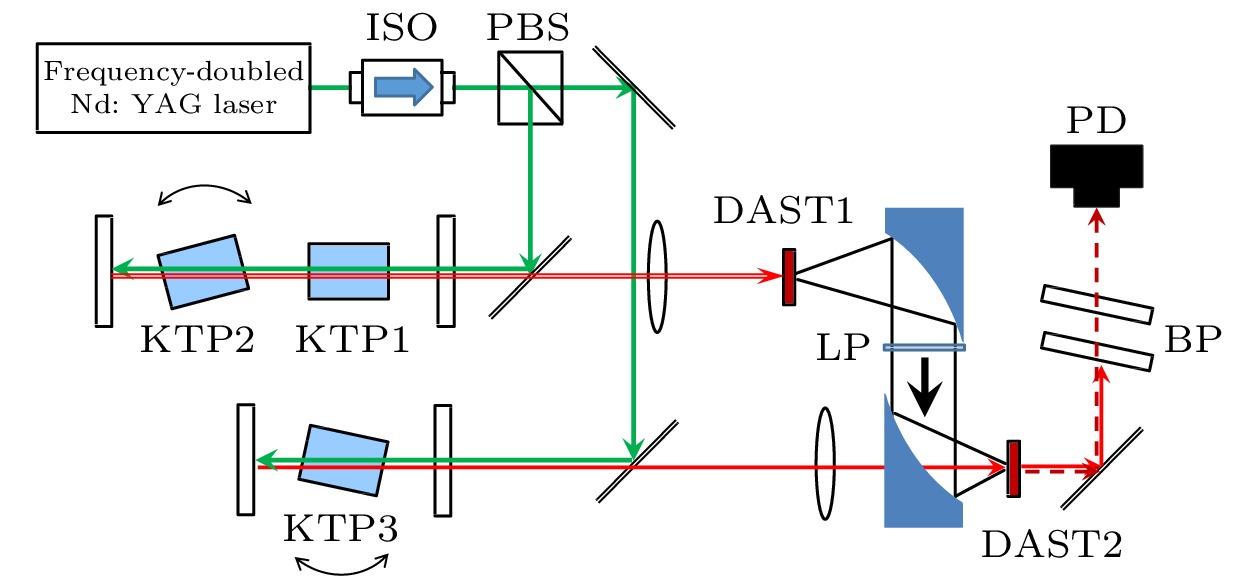
COVER ARTICLE
2021, 70 (5): 050701.
doi:10.7498/aps.70.20201908
Abstract +
Laser pumped terahertz (THz) wave up-conversion detection with high sensitivity, fast responsivity and wide frequency band is achieved at room temperature, based on home-made organic nonlinear crystals 4-N,N-dimethylamino-4′-N′-methyl-stilbazolium tosylate (DAST). Green laser pulses pumped KTiOPO4optical parametric oscillators are utilized as the sources of dual-wavelength near-infrared (NIR) beams (1.3–1.6 μm, for THz-wave difference frequency generation (DFG)) and a single NIR beam (1.2–1.4 μm, for up-conversion detection). The nonlinear medium for both THz-DFG and detection is DAST (grown by CETC-46). A nanosecond-time-resolved THz pulse is obtained with an InGaAs p-i-n photo-diode. The spectrum of the up-converted NIR light is acquired, which allows us to measure the THz frequency indirectly. The sensitivity (also at room temperature) is 4 orders better at 19 THz than the sensitivity of a commercial thermal detector (Golay Cell). The wide frequency band operation is realized with different sets of band-pass filters, which cover the entire range from 3.15 to 29.82 THz except 8.4 THz of the strong absorption peak of DAST. The dynamic range of a THz source based on DFG can be commonly improved by 2–3 orders, by changing the traditional thermal detector with the up-conversion detection. The presented technology can promote the applications of DFG THz source in the fields of high-resolution spectroscopy and imaging.

2021, 70 (5): 050702.
doi:10.7498/aps.70.20201322
Abstract +
Cavity-enhanced absorption spectroscopy is a highly sensitive trace gas measurement technology, and the algorithm for retrieving gas concentrations is critical. The absorption cross-section is traditionally used to retrieve the concentration. However, the absorption cross-section used in the fitting process is affected not only by the response function of the instrument and the light source, but also by temperature and pressure. The uncertainty of the absorption cross-section will influence the accuracy of the result. Therefore, in order to eliminate the measurement error introduced by the uncertainty of the absorption cross-section and the instrument response function, a concentration regression algorithm based on the absorption spectrum of the standard sample is proposed. The process of concentration inversion is optimized. The absorption spectrum of standard gas is used to fit the unknown spectrum. In order to verify the effectiveness of the algorithm, the incoherent cavity enhanced absorption spectroscopy (IBBCEAS) system based on a blue light-emitting diode (LED) operating at 440 nm is established to analyze the absorption spectrum of NO2; and the fitting effect, measurement accuracy and stability are compared with the counter parts from the traditional absorption cross-section method. In the experiment, the measured reflectance of the cavity mirror is 99.915%. Compared with the conventional absorption cross-section regression algorithm, the standard sample regression algorithm proposed in this paper shows good results, in which the measurement accuracy is increased by about quadruple. The Allan deviation shows that a detection limit of 5.3 ppb can be achieved at an integration time of 360 s. Finally, the performance of the experimental system is evaluated by measuring the NO2with different concentrations prepared by standard samples. The result shows good agreement with the theoretical value, which indicates that the improved spectral analysis algorithm is feasible and reliable for gas detection. This method can be used not only to measure NO2, but also to detect other gases, which shows great potential applications in monitoring the industrial emissions, atmospheric chemistry and exhaled breath analysis.
NUCLEAR PHYSICS
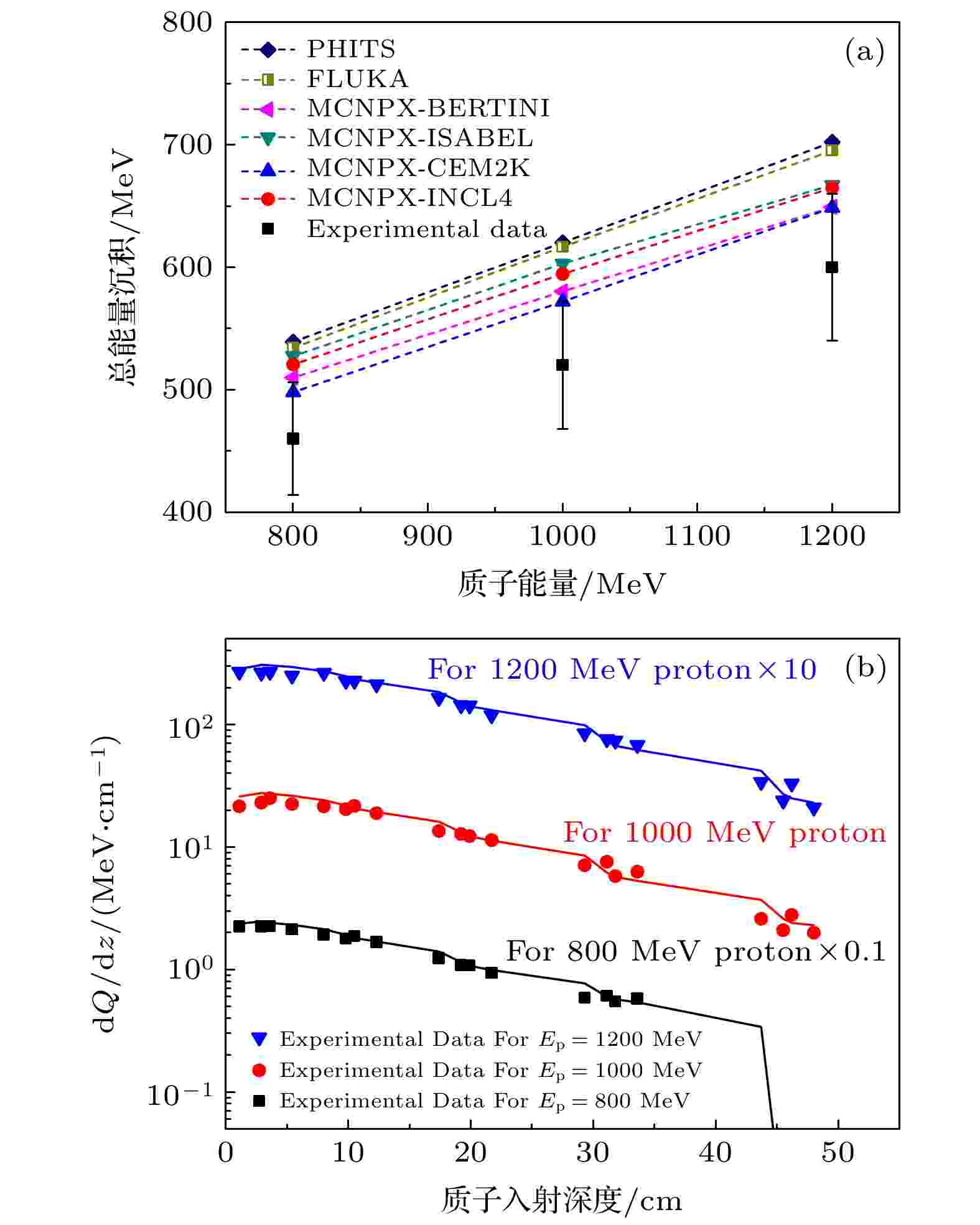
EDITOR'S SUGGESTION
2021, 70 (5): 052401.
doi:10.7498/aps.70.20201504
Abstract +
Energy deposition in spallation target induced by energetic protons is the foundation and the premise of the spallation target research. In this paper, several intra-nuclear cascade models including BERTINI, ISABEL, CEM2K and INCL4 contained in MCNPX package, together with FLUKA and PHITS Monte Carlo codes are used to calculate the energy deposition in lead (Pb) and tungsten (W) spallation target impinged by 800, 1000, and 1200 MeV protons. The contributions of different particles to the total energy deposition in the Pb target are obtained and compared with each other as well. The energy deposition distribution caused by 250 MeV protons in the W target is measured with thermoluminescence detectors (TLDs). The results indicate that the calculations from the MCNPX accord with experimental data, verifying that the Monte Carlo code has a high reliability for energy deposition simulation.
ATOMIC AND MOLECULAR PHYSICS
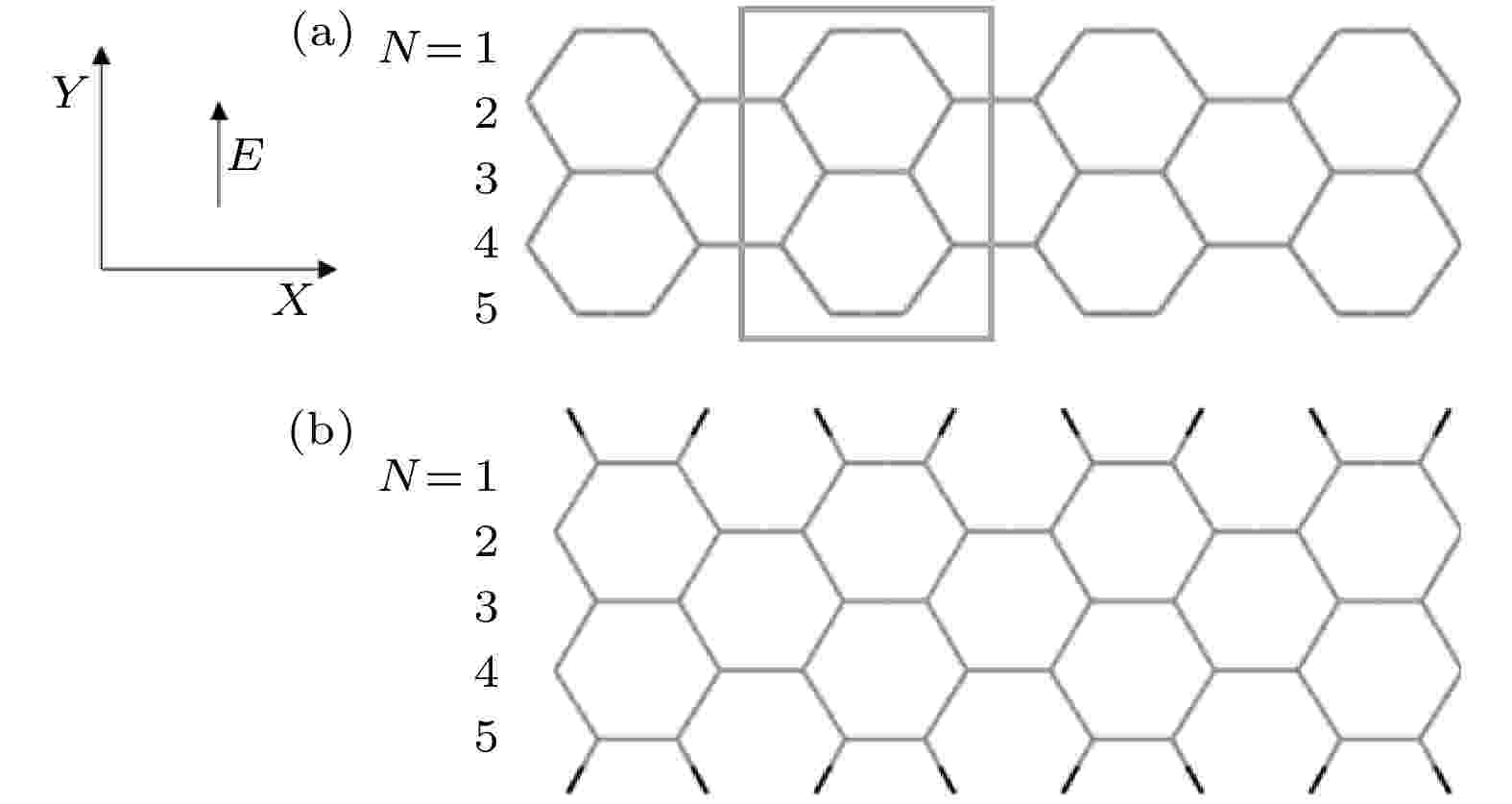
2021, 70 (5): 053101.
doi:10.7498/aps.70.20201619
Abstract +
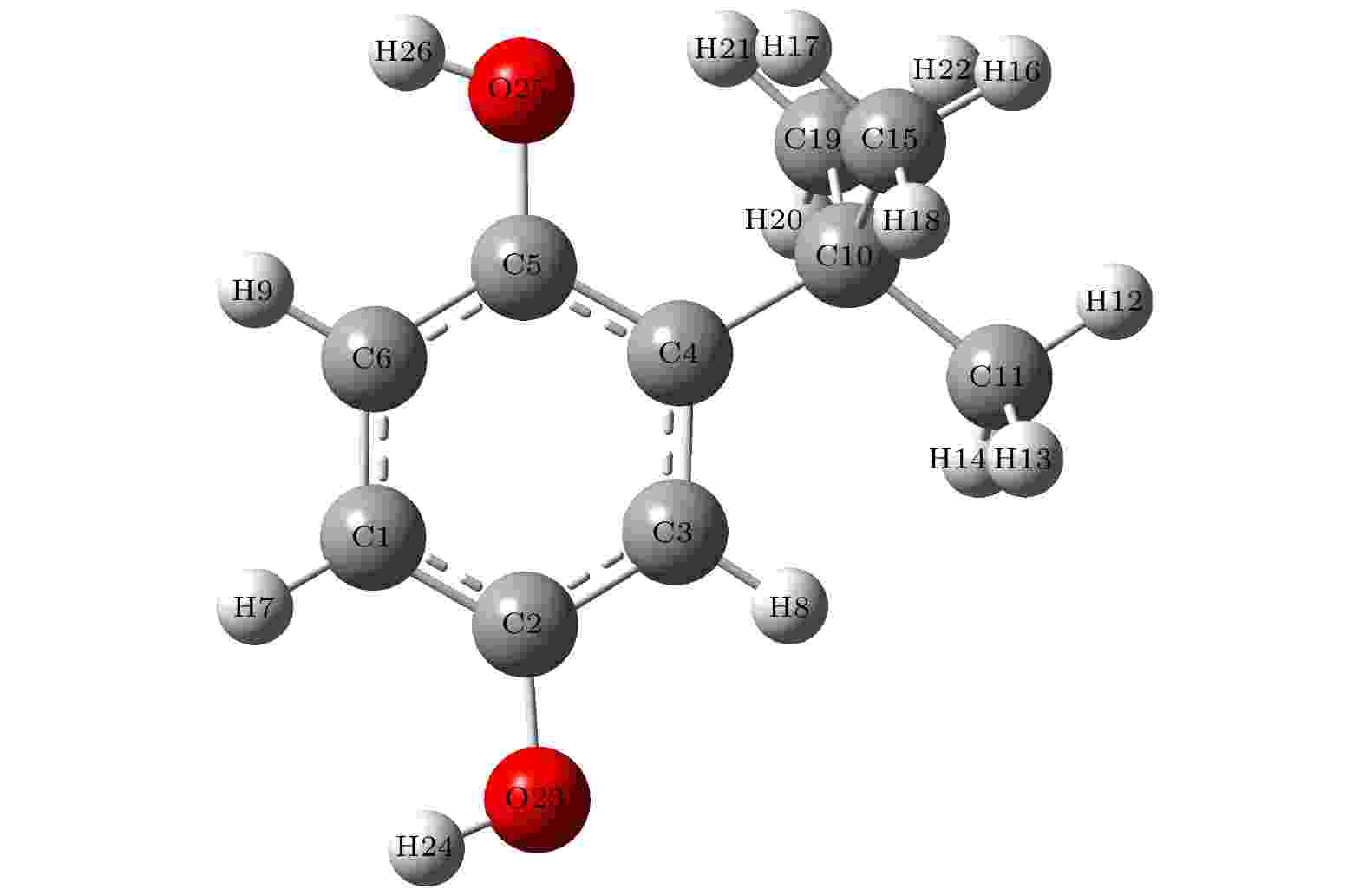
2021, 70 (5): 053102.
doi:10.7498/aps.70.20201555
Abstract +
Tert-butylhydroquinone (TBHQ) is an important food antioxidant. Based on density functional theory, the B3LYP functional is used to optimize the geometric configuration and calculate the frequency of TBHQ molecule in gas phase at a level of 6-311g (d, p) basis set. On this basis, based on the time-dependent density functional theory, SMD implicit solvent model is selected, and the first 50 excited states of molecule in ethanol solvent are calculated by using B3LYP functional and def2-TZVP basis set. Multiwfn software is used to analyze the vibration of IR spectrum, the influence of interaction among molecules on IR spectrum and the molecular orbital and electron-hole of UV spectrum. Experimentally, Fourier transform infrared spectrometer (FTIR) is used to measure the IR spectrum of TBHQ sample by KBr tablet method. The UV spectrum of the sample determined in the ethanol solvent by ultraviolet visible spectrophotometer. By comparative analysis, it can be seen that the theoretical spectra are in good agreement with the experimental spectra. The characteristic absorption peaks of each group in the IR spectra are obvious, and the theoretical peaks are in good agreement with the positions of the measured peaks. The hydrogen bonding of dimers and polymers in the TBHQ sample can weaken the O—H bond strength of a single molecule, thus weakening the vibration frequency of the O—H bond and resulting in a wide peak at 3670–3070 cm–1in the experimental IR spectrum. The UV spectra are mainly formed from the ground state to the first, second, sixth and seventh excited state. The maximum absorption peak in the UV spectrum is below 200 nm and is formed by the transitions of π→π* and σ→π*. The absorption peaks at 268.8 nm and 221.4 nm are formed by the transitions of n→π* and π→π*. It can be seen from the electron-hole distribution diagram that these four excitations are all electron local excitation. This study may play a certain role in understanding the molecular structure and excitation properties of TBHQ, as well as the formation mechanism of its IR and UV spectra, and also conduce to understanding its antioxidant properties.
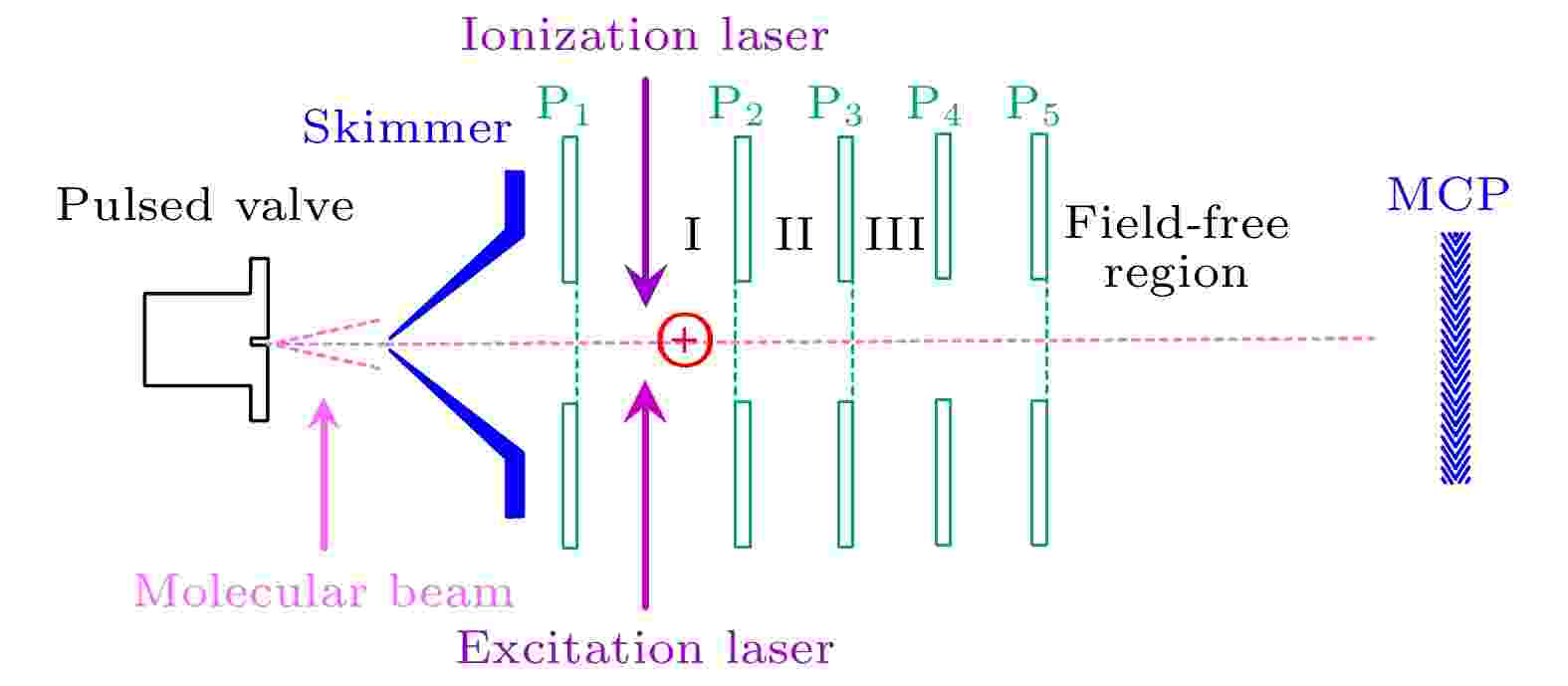
2021, 70 (5): 053301.
doi:10.7498/aps.70.20201273
Abstract +
Ionization energy (IE) is an important characteristic parameter of atoms or molecules. It plays an important role in the process of photophysics and photochemistry. The precise ionization energy is very important for relevant research. Especially, it is very useful for adjusting the signal of the zero-kinetic energy (ZEKE) spectrum, and it also plays a key role in judging the number of rotamers and molecular configuration. In linear time-of-flight mass spectrometers, pulsed electric fields are usually used to drive photo-ionized ions to the detector to produce the photoionization efficiency (PIE) spectrum. The ionization energy is directly obtained from the PIE curve. The uncertainty of the measured IE is usually greater than or equal to ± 10 cm–1. The ZEKE spectroscopy is based on the long-lived Rydberg state field ionization technology. In the ZEKE experiments, the laser excites molecules to the Rydberg state and then a pulsed field ionization (PFI) is used for measurement. A peak with high signal-to-noise ratio and narrow linewidth signal appears near the ionization threshold. Therefore, the more accurate ionization energy can be obtained, and the uncertainty of the measured value is about ± 5 cm–1. The 1,3-diethoxybenzene is an important benzene derivative, and experiments have confirmed that there are two rotamers, i.e. I (down-up) and III (down-down) in the supersonic molecular beam. In this paper, a linear time-of-flight mass spectrometer is used to measure the photoionization efficiency curves of 1,3-diethoxybenzene in electrostatic fields. From the linear fitting of the ionization energy values measured under different electric fields (Stark effect) to the square root of the field strengths, the precise ionization energy values of rotamer I and rotamer III are determined to be (62419 ± 2) cm–1and (63378 ± 2) cm–1, respectively. Compared with the accuracies of the values measured by the usual pulsed electric field acceleration mechanism and the ZEKE spectroscopy, the accuracy is improved from about ± 10 and ± 5 to ± 2 cm–1, respectively. The physical mechanism, advantages and disadvantages of different methods are analyzed and discussed. The present research results show that the ionization energy measured in the electrostatic field is more accurate, the physical meaning of the measurement process is clear, and the threshold data are easy to collect. This is the first report on the precise ionization energy of 1,3-diethoxybenzene rotamers.
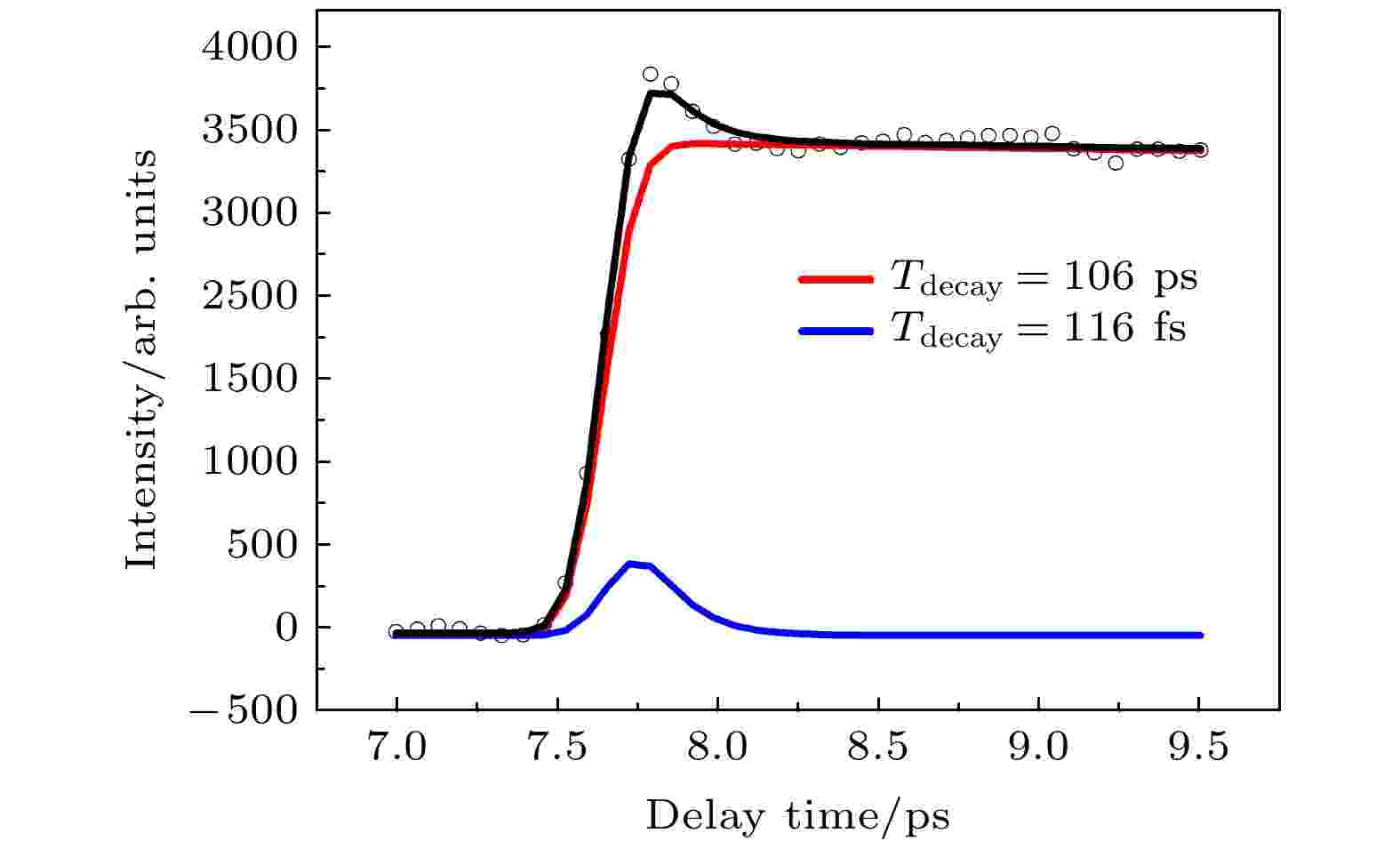
2021, 70 (5): 053302.
doi:10.7498/aps.70.20201473
Abstract +
Interaction of light with matter has always been important in the field of natural science. Particularly, the ultrafast radiationless relaxation induced by UV light of molecular electronic excited states accompanied by ultrafast energy transfer plays an important role in the natural photophysical, photochemical and biological reactions. Generally, the molecular electronic excited state can be deactivated through a variety of decay channels, including dissociation, isomerization, internal conversion, intersysterm crossing, vibrational energy redistribution, and autoionization. This complexity of relaxation channels brings about a wide variety of deactivation mechanisms. The ultrafast nonadibatic relaxation dynamics of the excited state of phenylacetylene is studied by using femtosecond time-resolved photoelectron imaging and femtosecond time-resolved mass spectrometry. The first excited state S2of phenylacetylene is excited by 235 nm pump light, and the excited state deactivation process is detected by 400 nm probe light. The time-dependent curves of parent ions include two exponential curves. One is the fast component with a time constant of 116 fs, and the other is the slow component with a time constant of 106 ps. The time-resolved photoelectron kinetic energy distribution is obtained from the time-resolved photoelectron images. Combined with the time-resolved photoelectron spectroscopy data, the fast component with a time constant of 116 fs is found to reflect the internal conversion process from S2state to S1state. The experimental results also show that S1state is arranged by internal conversion, and the inter system jump process to T1state is an important attenuation channel. This work provides a clearer physical picture for S1state nonadibatic relaxation dynamics of phenylacetylene.
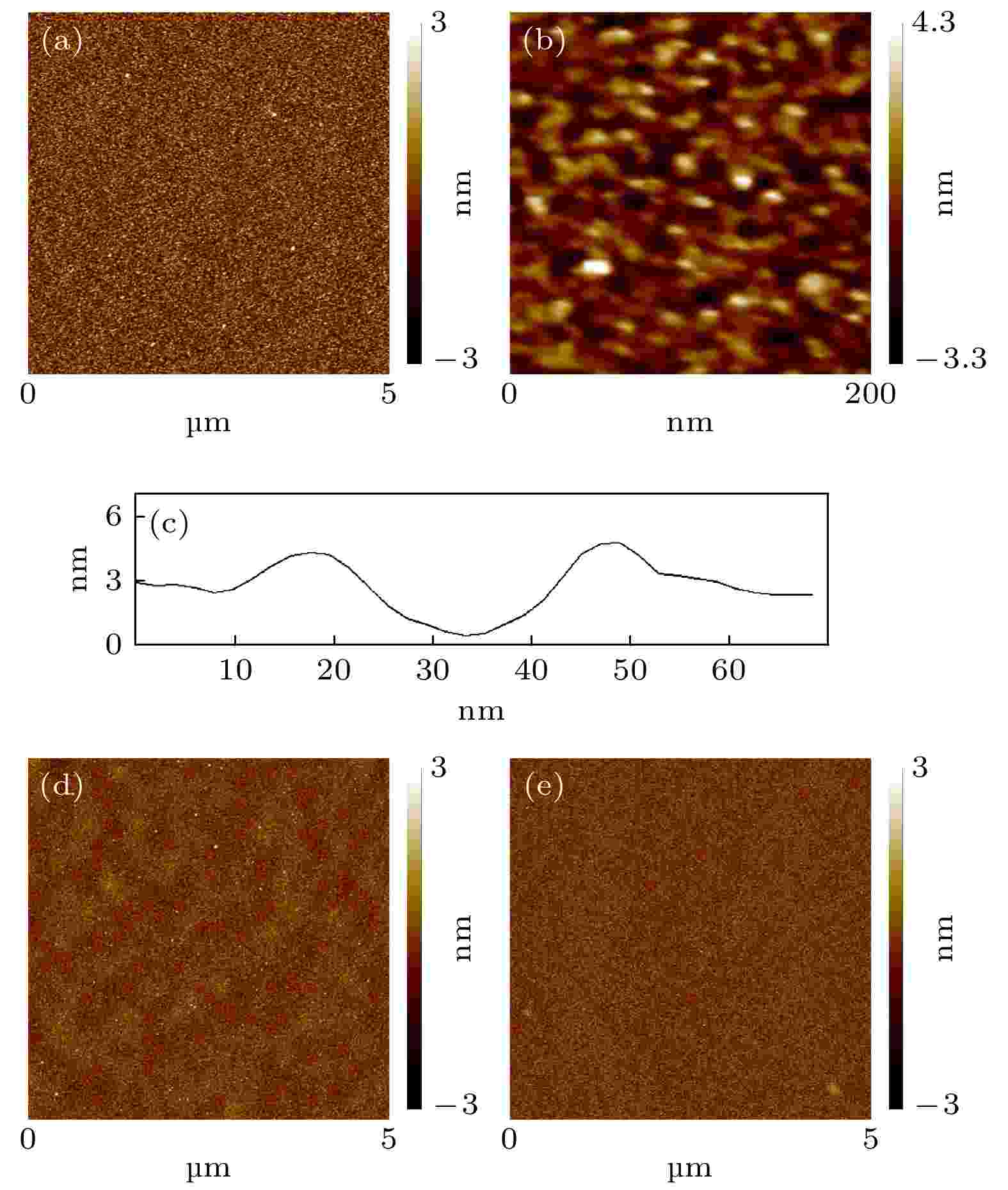
EDITOR'S SUGGESTION
2021, 70 (5): 053601.
doi:10.7498/aps.70.20201454
Abstract +
In this study we use the double step gas cluster ion beam treatment to improve smoothing process of mechanically polished 4H-SiC (1000) wafers and compare it with conventional single-step smoothing. The first step is a higher energy treatment with 15 keV Ar cluster ions, and the second step is a lower 5 keV treatment. Single-step treatments are performed at 15 and 5 keV. It is shown that single-step 15 keV smoothing as compared with lower 5 keV one is very effective for removing the initial surface morphological feature (scratches), however, cluster ions impacting on the surface can create larger craters, resulting in roughnessRqof 1.05 nm. Whereas, 5 keV treatment at a selected fluence cannot remove initial scratches, which requires using higher fluences, i.e. such smoothing becomes time consuming. On the other hand, crater morphology with such a treatment is less developed, hence, the roughness slightly decreases to 0.9 nm. Using the double-step treatment, one can obtain the surface with lowerRqroughness of 0.78 nm as compared with single-step treatment, at the same total cluster ion fluence. Therefore, the double-step treatment combines the advantages of the effective smoothing of scratches at high energy and smaller crater morphology at low energy. To evaluate the contribution of the cluster morphology introduced by the accelerated clusters into the total roughness, the cluster ion beam treatment of an atomically smooth 4H-SiC (1000) surface is also carried out. It is shown that the crater diameter increases in a range of 15–30 nm with the cluster energy increasing. More detailed analysis of the smoothing process is carried out by using two-dimensional isotropic PSD function. It is shown that the cluster treatment of mechanically polished 4H-SiC wafers effectively reduces the roughness in a wavelength range of 0.05–0.20 μm and the efficiency of smoothing is higher at higher cluster energy. In a range of 0.02–0.05 μm, a roughening effect is observed, which is due to the formation of craters. This roughening effect can be effectively reduced by the subsequent lower energy step treatment, which can be shown by the PSD function analysis of the smooth SiC surface treated initially by cluster ion beam.
ELECTROMAGNETISM, OPTICS, ACOUSTICS, HEAT TRANSFER, CLASSICAL MECHANICS, AND FLUID DYNAMICS

2021, 70 (5): 054201.
doi:10.7498/aps.70.20201362
Abstract +
The conventional phase retrieval wavefront sensing approaches mainly refer to a series of iterative algorithms, such as G-S algorithms, Y-G algorithms and error reduction algorithms. These methods use intensity information to calculate the wavefront phase. However, most of the traditional phase retrieval algorithms are difficult to meet the real-time requirements and depend on the iteration initial value used in iterative transformation or iterative optimization to some extent, so their practicalities are limited. To solve these problems, in this paper, a phase-diversity phase retrieval wavefront sensing method based on wavelet transform image fusion and convolutional neural network is proposed. Specifically, the image fusion method based on wavelet transform is used to fuse the point spread functions at the in-focus and defocus image planes, thereby simplifying the network inputs without losing the image information. The convolutional neural network (CNN) can directly extract image features and fit the required nonlinear mapping. In this paper, the CNN is utilized to establish the nonlinear mapping between the fusion images and wavefront distortions (represented by Zernike polynomials), that is, the fusion images are taken as the input data, and the corresponding Zernike coefficients as the output data. The network structure of the training in this paper has 22 layers, they are 1 input layer, 13 convolution layers, 6 pooling layers, 1 flatten layer and 1 full connection layer, that is, the output layer. The size of the convolution kernel is 3 × 3 and the step size is 1. The pooling method selects the maximum pooling and the size of the pooling kernel is 2 × 2. The activation function is ReLU, the optimization function is Adam, the loss function is the MSE, and the learning rate is 0.0001. The number of training data is 10000, which is divided into three parts: training set, validation set, and test set, accounting for 80%, 15% and 5% respectively. Trained CNN can directly output the Zernike coefficients of order 4–9 to a high precision, with these fusion images serving as the input, which is more in line with the real-time requirements. Abundant simulation experiments prove that the wavefront sensing precision is root-mean-square(RMS) 0.015λ, when the dynamic range of the wavefront is the aberration of low spatial frequency within 1.1λof RMS value (i.e. the dynamic range of Zernike coefficients of order 4–9 is
$[- 0.5\lambda \,, \, 0.5\lambda]$
). In practical application, according to the system aberration characteristics, the number of network output layer units can be changed and the network structure can be adjusted based on the method presented in this paper, thereby training the new network suitable for higher order aberration to realize high-precision wavefront sensing. It is also proved that the proposed method has certain robustness against noise, and when the relative defocus error is within 7.5%, the wavefront sensor accuracy is acceptable. With the improvement of image resolution, the wavefront sensing accuracy is improved, but the number of input data of the network also increases with the sampling rate increasing, and the time cost of network training increases accordingly.
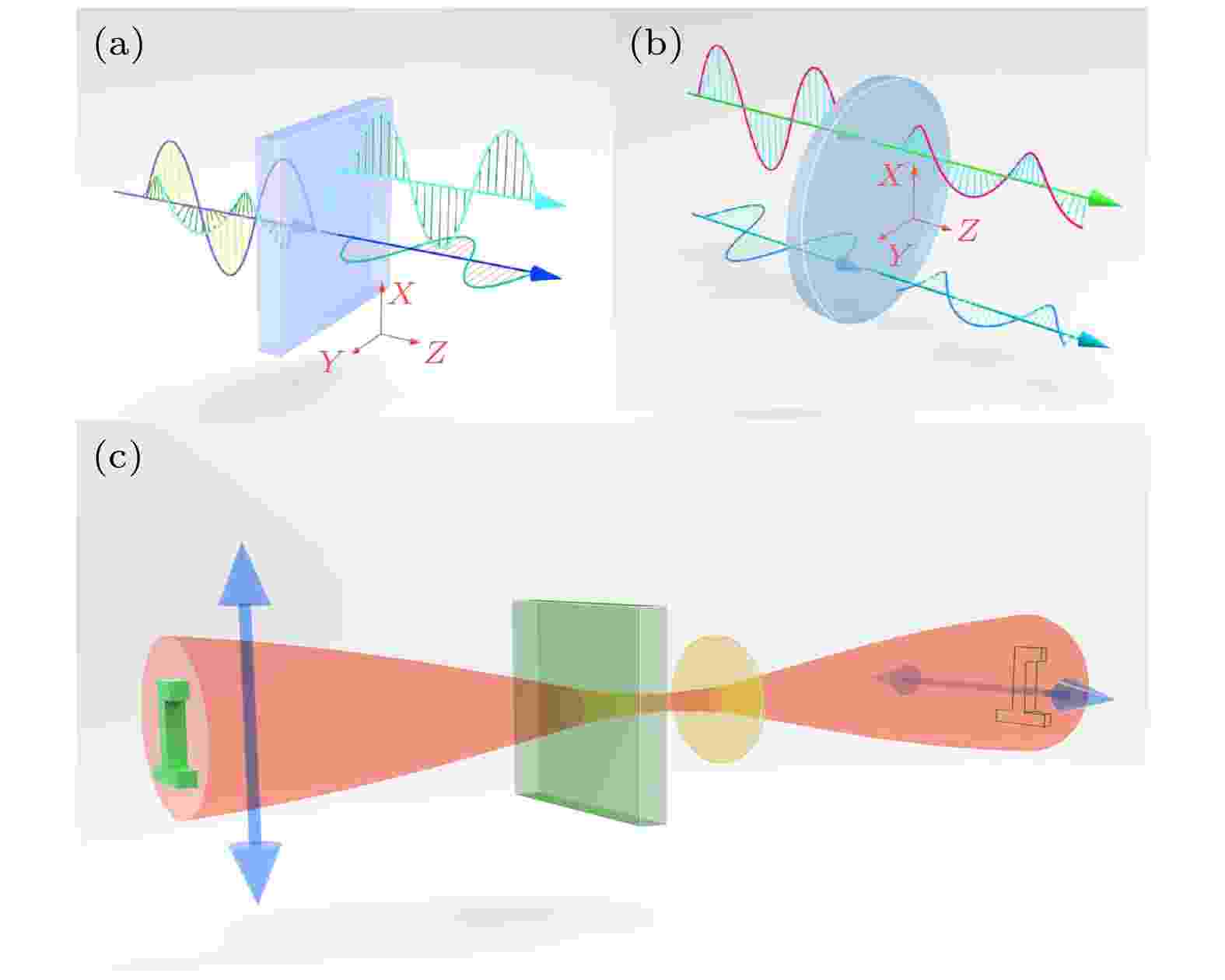
2021, 70 (5): 054202.
doi:10.7498/aps.70.20201184
Abstract +
Optical differential operation is the core principle of optical detection of edge images. Compared with the traditional digital image processing methods, the optical differential operation has high efficiency, simple structure, and needless to consider algorithms and power consumption. An optical differential operation device based on anisotropic crystal is proposed in this paper. Omni-directional edge imaging under multi-angle spectral components is realized by using a customized crystal chip. The scheme is mainly based on the birefringence effect of anisotropic crystal. It needs to separate the left and right circularly polarized component of the beam horizontally, and then filter the linearly polarized light in the middle. The whole device is integrated into a straight optical path. Although it has higher requirements for the thickness of crystal, it is simpler, cheaper and more stable than spin Hall effect and super surface principle. The experimental results also demonstrate that the scheme can be used in quantum observation, biological cell and medicine.
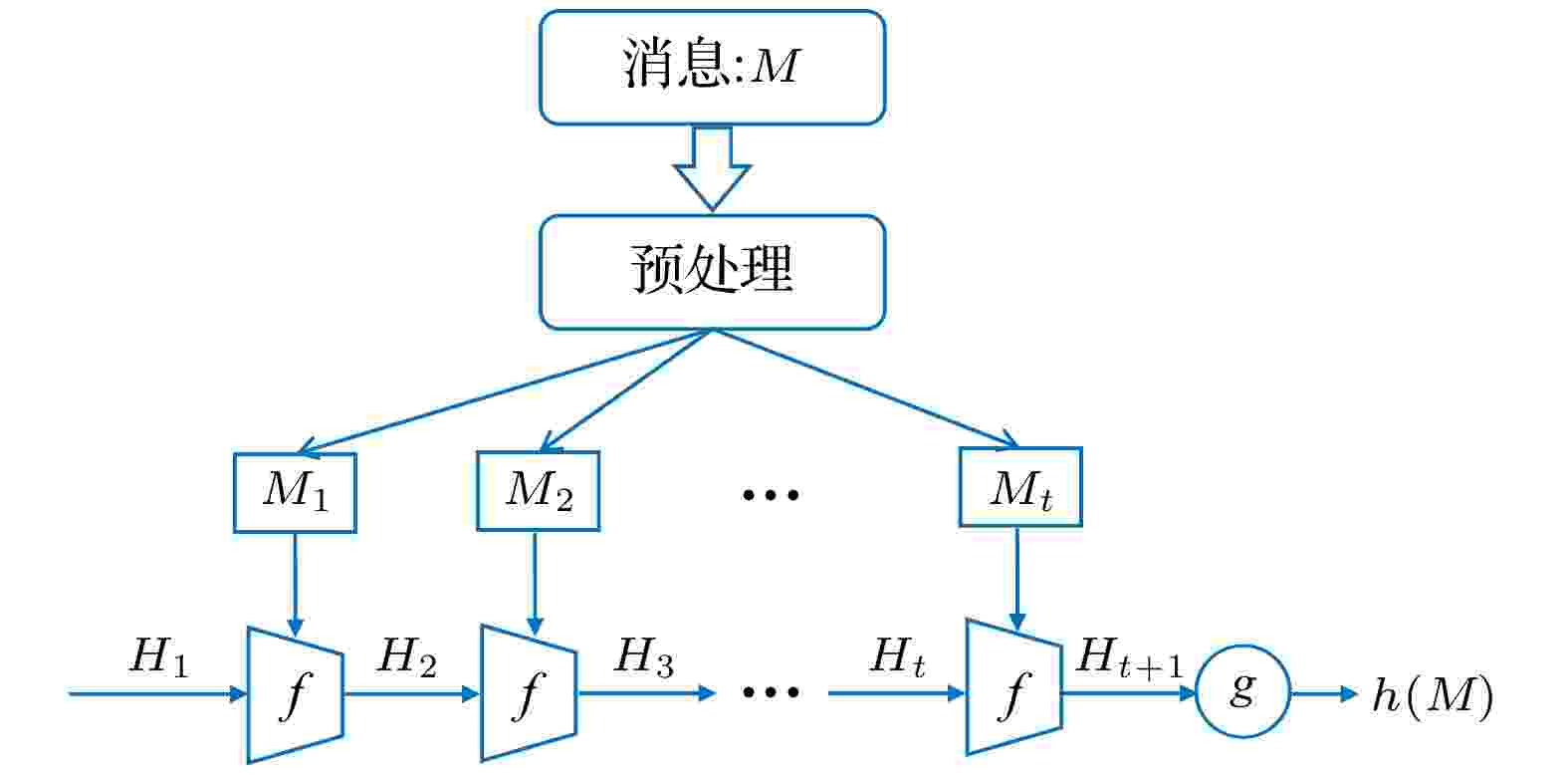
EDITOR'S SUGGESTION
2021, 70 (5): 054203.
doi:10.7498/aps.70.20201492
Abstract +
Hash functions, which can extract message digest from input messages as output, play an important role in digital signature and authentication. Meanwhile, Hash functions are essential in many cryptographic protocols and regimes. With the research becoming more and more in depth, a series of Hash functions is proposed, such as MD series and SHA series. At the same time, the security analysis and attacks against Hash functions are carried out. The security of Hash functions is threatened. In this case, how to improve the security of the Hash functions becomes the primary concern. In this paper, an optical Hash function based on the interaction between light and multiple scattering media is proposed. Unlike most of the traditional Hash functions which are based on mathematical transformations or complex logic operations, this method innovatively takes advantage of the natural random scattering effect of multiple scattering media on coherently modulated light, and realizes the “confusion” and “diffusion” of modulated light, which satisfies the core functional requirement of the Hash function: one-way encoding/encryption with strong security. The photoelectric hybrid system designed by this method can effectively simulate the "compression function" in the Hash function. Combined with the Sobel filter with feature extraction function, the input data of arbitrary length can be compressed and encrypted into the output with a fixed length of 256-bit (Hash value). The principle of the proposed optical Hash function can be described as follows. 1) Two 8-bit images with a size of 16×16 pixels are loaded in SLM1(amplitude-only spatial modulator) and SLM2(phase-only spatial modulator) respectively. 2) The coherent wavefront is modulated by SLM1and SLM2, and then propagates on multiple scattering media. 3) A speckle pattern is recorded by CCD because of the confusion of multiple scattering media. 4) The features of the speckle pattern, which is extracted by Sobel filter, serve as the input of the next compression function. For the unpredicted and non-duplicated disorder multiple scattering media, it is tremendously difficult to determine the internal state of the multiple scattering media. Therefore, the proposed optical Hash function is considered to have a high security. A series of simulation results shows that the proposed optical Hash function has a good “avalanche effect” and “collision resistance”, and its security performance is comparable to that of the most widely used traditional Hash functions (MD5 and SHA-1).
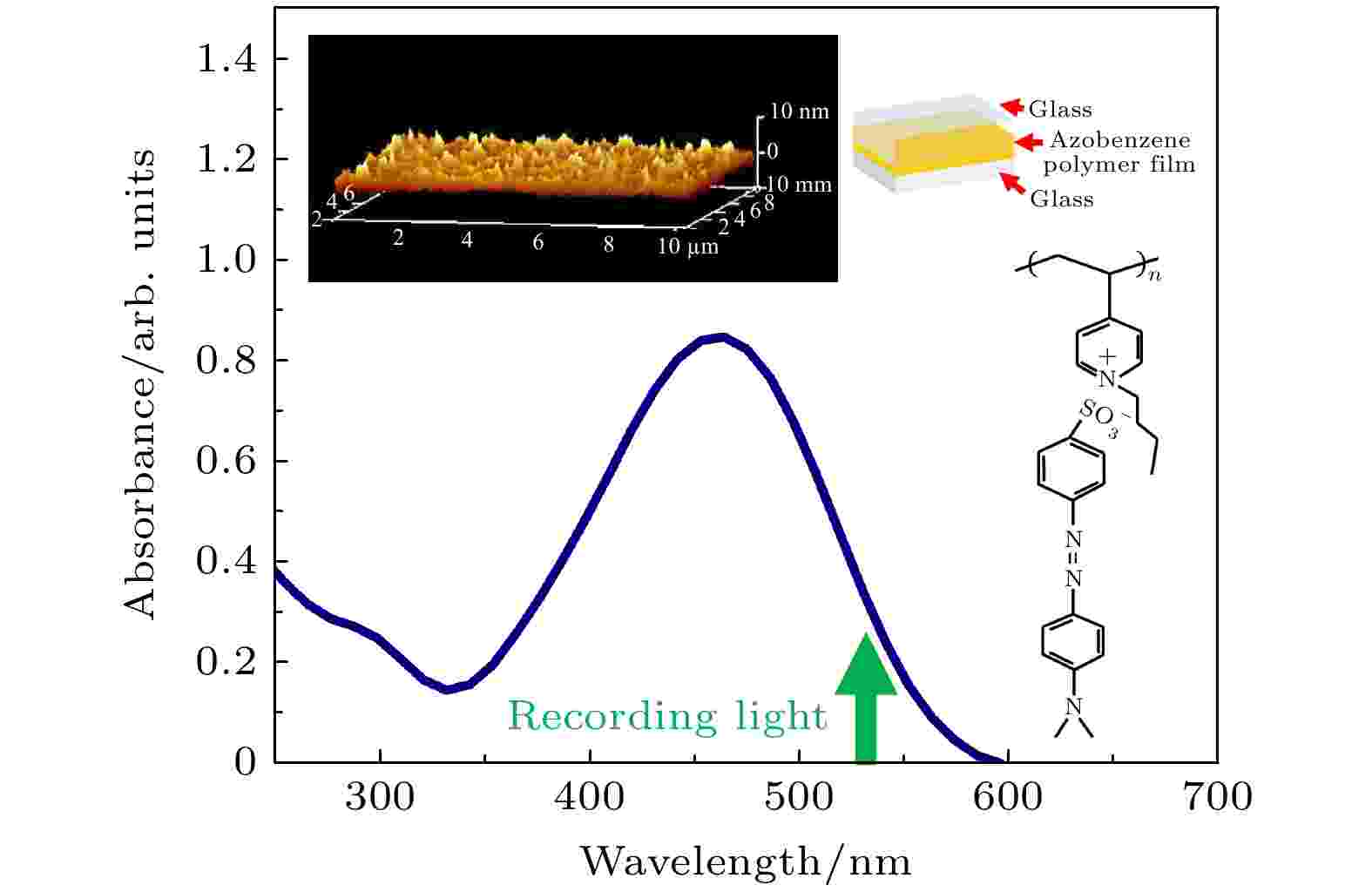
2021, 70 (5): 054204.
doi:10.7498/aps.70.20201496
Abstract +
In this paper the optical vortices with topological chargeq= –1, 1, 2, 4 are recorded in azo polymer films by using holographic technology. The forked holographic gratings formed by the Gaussian beam and optical vortex beam are recorded in the sample films, the original forked holographic grating and the recording rate are analyzed. The vortex beam is reconstructed by illuminating the sample film with a reference beam, and the recording quality is analyzed. Also the erasability and durability of the sample are tested. The experimental results show that the recording rates of vortex beams with different topological charges are relatively uniform, which means that the optical vortices with different topological charges can be recorded at the same speed. The forked holographic grating of the high-order optical vortex splits in the recording process due to the disturbances, such as anisotropic nonlinear light, atmospheric turbulence, and background light field. However, the split vortex beam still maintains a stable ring structure. The reconstructed optical vortex and the original optical vortex are highly consistent in morphology, and the interference fringes of the reconstructed optical vortices are highly consistent with the original vortex holographic gratings, indicating that the topological charge information in the optical vortices can be effectively recorded and read out. The recorded information can be erased by heating the sample to about 97 ℃, and new information can be re-recorded after cooling. There appears no fatigue in the sample after the information has been erased 100 times and good durability is still retained. Optical vortices theoretically have infinite states of topological charges, based on which great success is achieved in optical communication and information encoding. Therefore, storing and reading information of topological charges in optical vortices may have potential applications in optical information storage.
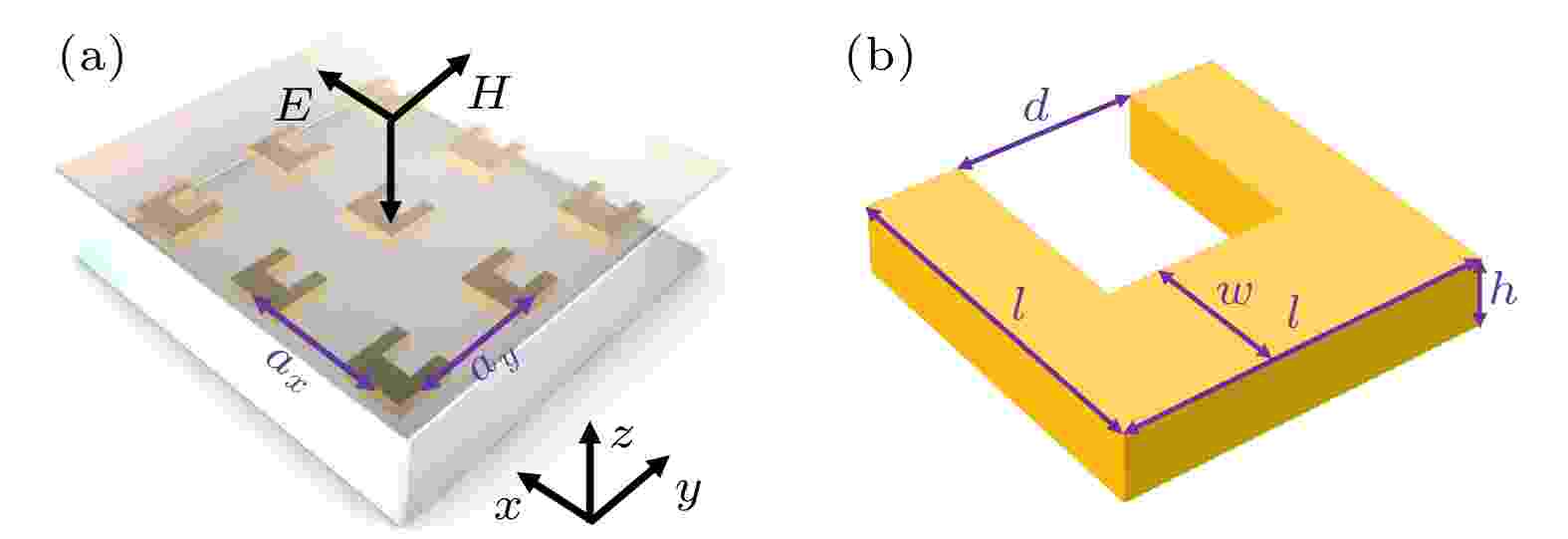
2021, 70 (5): 054206.
doi:10.7498/aps.70.20201424
Abstract +
In this paper, we theoretically study the condition for the strong coupling between magnetic resonance mode of the two-dimensional periodically arranged gold split-ring resonators and the diffraction mode of the periodic array and its influence on the second harmonic generation efficiency. By controlling the size of the period of the array structure in thex-axis andy-axis, the diffraction mode is excited near the magnetic resonance provided by the gold split-ring resonator, solely in one of the directions. In both cases, the diffraction mode and the magnetic resonance coincide in the linear resonance spectrum, but by analyzing the electric field distribution at the position of the diffraction mode, it can be found that when
${a_x}$
is much larger than
${a_y}$
, the electric field direction of the diffraction mode is perpendicular to the polarization direction of the incident light, and no strong coupling occurs. Therefore, the dilution effect is dominant, and the second harmonic intensity gradually decreases with the increase of the period. When
${a_y}$
is much larger than
${a_x}$
, the electric field direction of the diffraction mode is the same as the polarization direction of the incident light. At this time, the diffraction mode and the magnetic resonance mode are strongly coupled. As the period increases, the second harmonic intensity first increases and then decreases. The increase is due to the dominant mode coupling and the decrease is due to the dominant dilution effect. When the number density of split-ring resonators is reduced to about 1/4 of the original one, the second harmonic intensity can be increased by more than twice. From this, we find that the strong coupling between diffraction mode and magnetic resonance can occur when the electric field direction of the diffraction mode is consistent with the polarization direction of incident light, thus generating the surface lattice resonance to achieve near-field enhancement. In short, the rectangular periodic structure is used to distinguish the field enhancement effects in different directions, and the second harmonic enhancement can still be achieved when the number density of split-ring resonators is reduced, which relaxes the requirements for processing technology. This research provides a new possible way to improve the second harmonic generation efficiency based on metal metasurfaces.
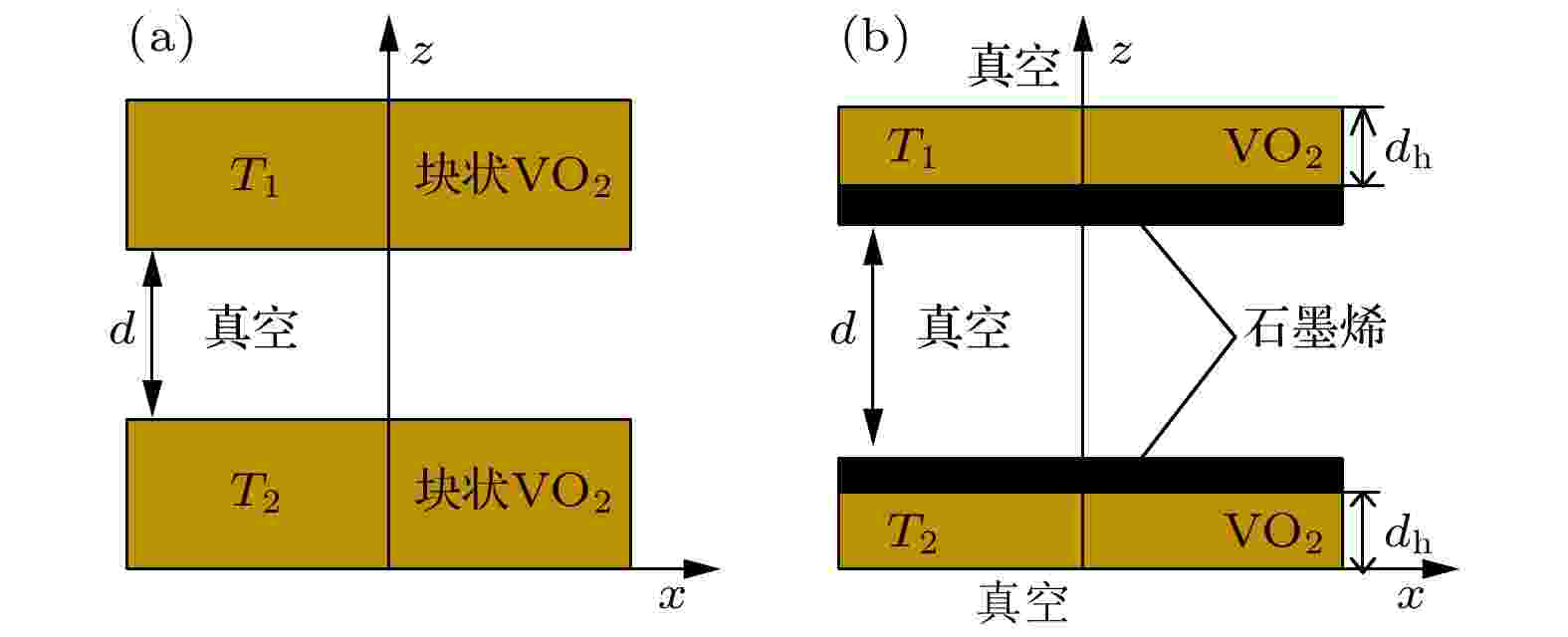
2021, 70 (5): 054207.
doi:10.7498/aps.70.20201360
Abstract +
Near-field thermal radiation refers to the radiation produced by two radiators in a narrow gap that is smaller than the characteristic wavelength. The studies of near-field thermal radiation began in the 1960s and 1970s. Some researchers have reported that near-filed thermal radiation can be enhanced by orders of magnitude higher than that of far-field radiation by photon tunneling and surface polariton. With the development and application of nanotechnology, the near-field heat radiation has developed into a research hotspot in the field of heat radiation. Recent studies have shown that the properties of near-field thermal radiation can be enhanced by optimizing the structures of radiators (covered by two-dimensional (2D) materials, such as graphene and black phosphorus), choosing radiation materials (hexagonal boron nitride, silicon dioxide, vanadium dioxide), and selecting appropriate physical parameters (chemical potential, vacuum distance, film thickness) of the radiator materials. According to the fluctuation dissipation theory and by solving the Maxwell equation and the green's function, in this article we report the near-field thermal radiation of the two half-infinite flats, including vanadium dioxide V/V, vanadium dioxide covered by graphene GV/GV and vanadium dioxide film covered by graphene GV0/GV0. The near-field thermal radiations in these structures are influenced by physical parameters, such as vacuum spacing, thickness of vanadium dioxide film and chemical potential of graphene. The results show that near-field thermal radiation of GV0/GV0 (38088.43 W/m2) is 8.6 times stronger than that of GV/GV (4426.73 W/m2, vacuum distance is 10 nm, chemical potential is 0.1 eV), and near-field thermal radiation of GV/GV (4426.73 W/m2) is 35 times stronger than that of V/V (127.21 W/m2, vacuum distance is 10 nm, chemical potential is 0.1 eV). For these three structures, thermal radiation decreases gradually by widening the vacuum distance. Moreover, thermal radiation also decreases by thickening vanadium dioxide film. While thermal radiation of GV0/GV0 decreases 3.34 times as chemical potential of graphene increases from 0.1 (38088.43 W/m2) to 0.6 eV (11399.80 W/m2). In this paper, the near-field heat radiation between vanadium dioxide and graphene is systematically investigated, which will give the guidance in the relevant experiment and practical applications of near-field heat radiation between vanadium dioxide and graphene.
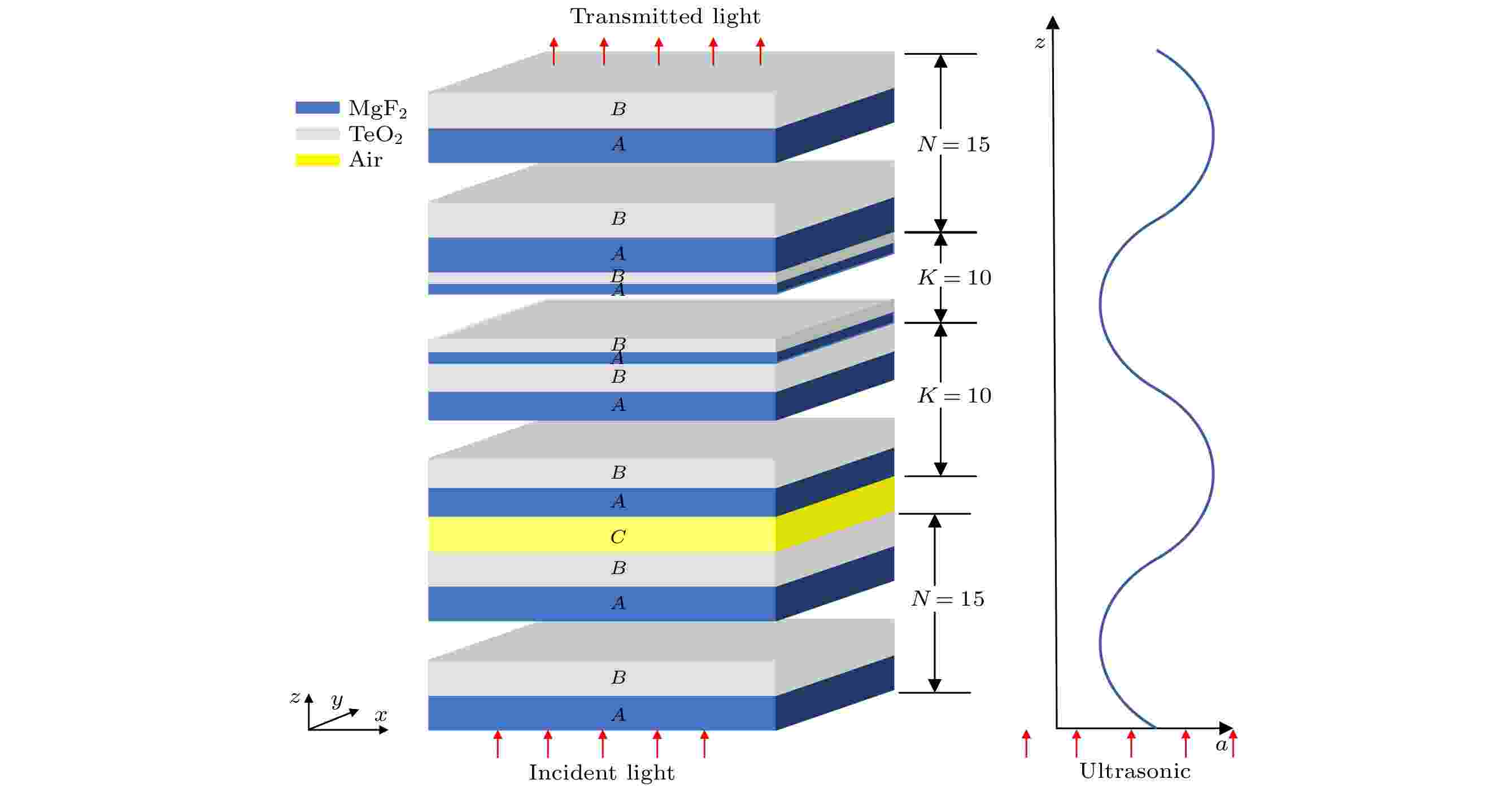
2021, 70 (5): 054208.
doi:10.7498/aps.70.20201461
Abstract +
In this paper, an acousto-optic tunable flat top filter is proposed by using one-dimensional coupled-cavity photonic crystal, and two kinds of materials, i.e. magnesium fluoride and tellurium dioxide, are selected. Based on the theory of acousto-optic effect, the thickness and refractive index of one-dimensional coupled cavity photonic crystal acousto-optic medium are changed by varying the ultrasonic frequency. After the parameters of acousto-optic medium are changed, the central wavelength of flat top filter of transmission spectrum shifts toward the short wave direction, thus realizing tunable filtering function. Based on the transfer matrix method and the theory of acousto-optic effect, the theoretical model of the flat top filter is established. The rectangularity, passband bandwidth, insertion loss and tunability of flat top filter are simulated by COMSOL software. The results show that the tuning effect can be achieved by applying a certain frequency of ultrasound in the case of different ultrasonic amplitudes. The decreasing trends of transmittance are basically identical in the process of changing ultrasonic frequency in the case of different amplitudes. When the central wavelength of the flat top filter increases from 1510 nm to 1514 nm, the transmissivity corresponding to the central wavelength increases sharply from 37% to 90%; when the central wavelength of the flat top filter continuously increases to 1562 nm, the transmittance corresponding to the central wavelength increasing gently from 90% to 97% in the case of different amplitudes. Considering the transmissivity required to exceed 90% in the passband of flat top filter and the cost of ultrasonic generator, the ultrasonic wave with an amplitude of 0.4 nm is selected as the research object. The flat top filter with 5–6 nm central wavelength and 1514–1562 nm tunable flat top filter can be realized by applying ultrasonic wave with the frequency in a range of 6–11 MHz. In the tunable range, the highest insertion loss is only 2.23 dB, the lowest is only 0.78 dB, and the lowest rectangularity is 1.4. In a practical flat top filter with machining error within 5 cm, the deviation of center wavelength, rectangularity, insertion loss and passband bandwidth of flat top filter are all very small. The flat top filter has the characteristics of easy design and integration, flat passband, wide tunable range, stable passband bandwidth, low insertion loss and high quality factor. It has important applications in optical communication fields such as optical switch, tunable fiber laser and fiber sensing.
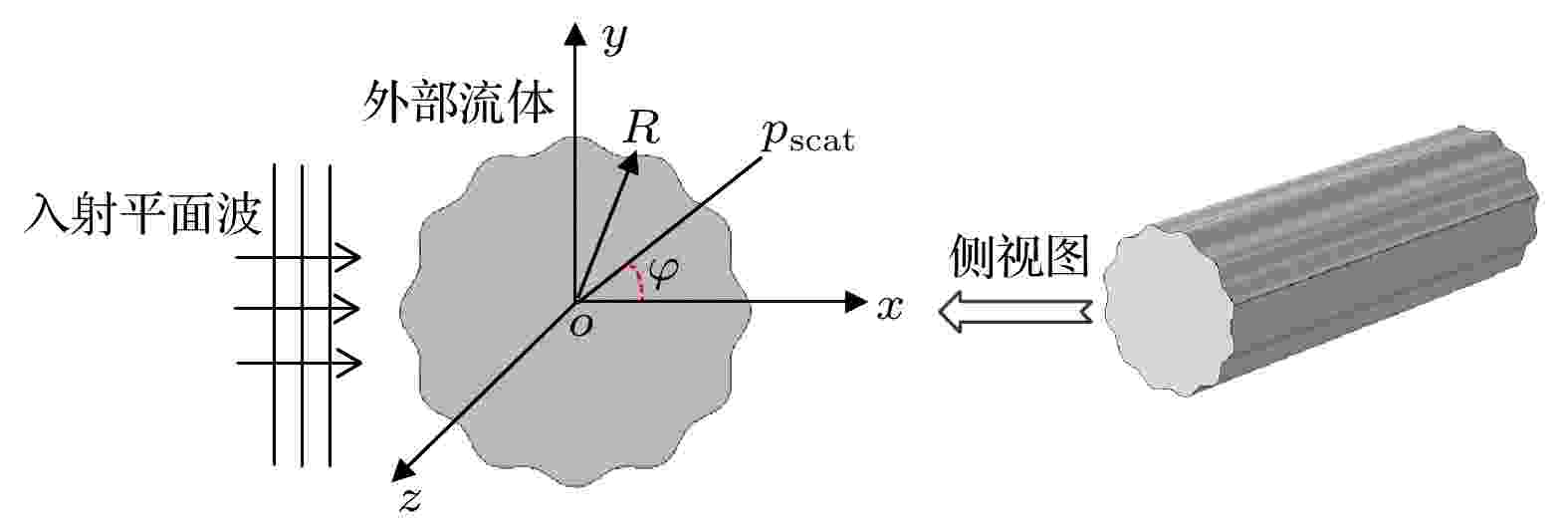
2021, 70 (5): 054301.
doi:10.7498/aps.70.20201535
Abstract +
Backscattering enhancement associated with subsonic Rayleigh wave resonance of a polymethlmethacrylate (PMMA) cylinder is observed at low frequencies in water, which suggests that the PMMA cylinders may have essential applications in the low-frequency standard scatterer design. A slightly deformed surface structure with regular corrugation is presented to manipulate the low-frequency backscattering resonance frequency of PMMA cylinder passively. Using the perturbation method, the approximate resonance frequency shift is derived for an infinite slightly deformed cylinder with regular corrugations. Based on the phase matching of Rayleigh waves, the mechanism of low-frequency resonance frequency shift is revealed. Studies show that compared with a bare cylinder, a small boundary deformation can cause the propagation path of Rayleigh waves to change, namely, the Rayleigh waves propagate along the slightly deformed surface with regular corrugations. The modified propagation path can cause the propagation phase to change, which brings about the low-frequency backscattering resonance frequency shift of a PMMA cylinder. Furthermore, how the resonance frequency shifts with the deformation coefficient and period of the corrugation is discussed in detail. The backscattering resonance frequency of the regular corrugated cylinder shifts to low frequency with the increase ofξunder the condition of the deformation coefficientξ> 0, but shifts to high frequency with the decrease ofξatξ< 0, and the resonance frequency shift increases with the increase of absolute value of deformation coefficient. When corrugation periodm< 10, the phase variation withmis too small, so the corrugation period has little effect on the resonance frequency shift. Finally, acoustic scattering experiment of the regular corrugated cylinder is conducted in the tank. The resonance frequency shift is obviously observed in the experiment, which is in good agreement with the theoretical prediction. Hence, the characteristics of backscattering enhancement associated with subsonic Rayleigh wave and the resonance frequency shifts make the PMMA deformed cylinder have potential applications such as in standard scatter design and identification using “AcoustiCode”.
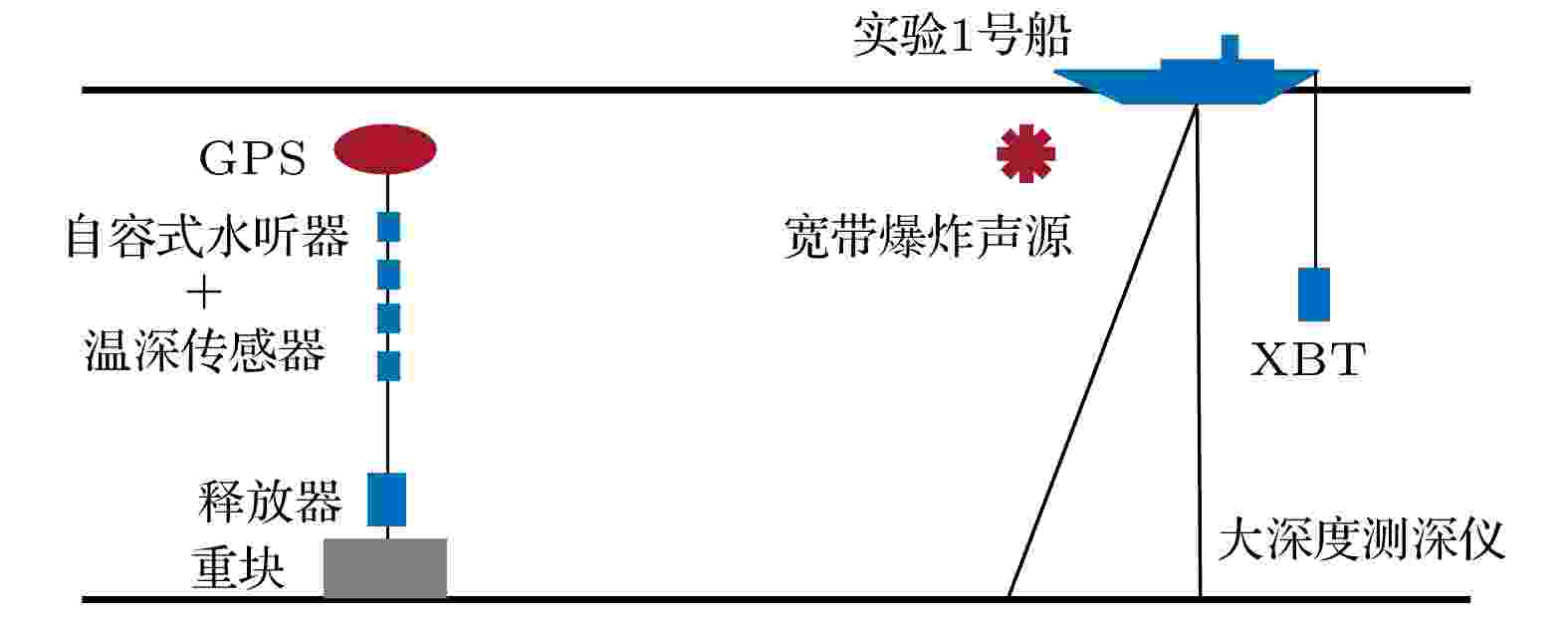
2021, 70 (5): 054302.
doi:10.7498/aps.70.20201549
Abstract +
Surface duct is a common duct due to strong sea winds and sea-atmosphere interactions in winter and it is an excellent waveguide in which energy may propagate a long distance. However, the rough interface formed by sea surface waves will seriously damage this excellent performance. In this study, the experimental data of sound propagation over the continental slope in the South China Sea are used to analyze the characteristics of sound propagation in a surface duct. Modeling analyses based on the parabolic equation model RAM and ray trace theory BELLHOP are used to examine these characteristics. The parameters of sea bottom, source depth, wind-driven sea surface, and swell-containing sea surface are taken into consideration in the model. The results show that when the source is located in the surface duct, the parameters of the sea bottom have little influence on sound propagation, while the change of source depth exerts some effects on the sound propagation. By combining the Pierson Moscowitz (PM) spectrum with Monte Carlo method, the rough sea surface is investigated. Since the PM spectrum is related only to wind speed, the wind-driven sea surface is generated by using the actual wind speed measured by the shipborne anemometer. The swell-containing sea surface is defined as a superposition of a sinusoidal pressure-release surface and the wind-driven sea surface. By comparing the effects of two sea surfaces on sound propagation, it is found that when the wind speed is small, swells play an important role in the surface-duct propagation. Experimental data show that for the acoustic signal with a center frequency of
$1000\;{\rm{Hz}}$
, the swell-containing sea surface brings around
$10 \;{\rm{dB}}$
loss to a distance of
$70 \;{\rm{km}}$
. For the two kinds of rough sea surfaces, rays at launch angles of
$\pm 1^{\circ}, 0^{\circ}$
are plotted to examine their effects on sound propagation. The results indicate that the swell-containing sea surface which has greater roughness makes rays go toward the sea bottom, thus resulting in larger loss. Therefore, in order to investigate the characteristics of the sound field in the northern South China Sea in winter, especially with high frequency sound signals, the influences of not only winds and waves, but also the swells from the surrounding sea should be taken into consideration. It is important to study the characteristics of sound propagation with swells for improving the performance of sonar equipment in poor sea conditions.
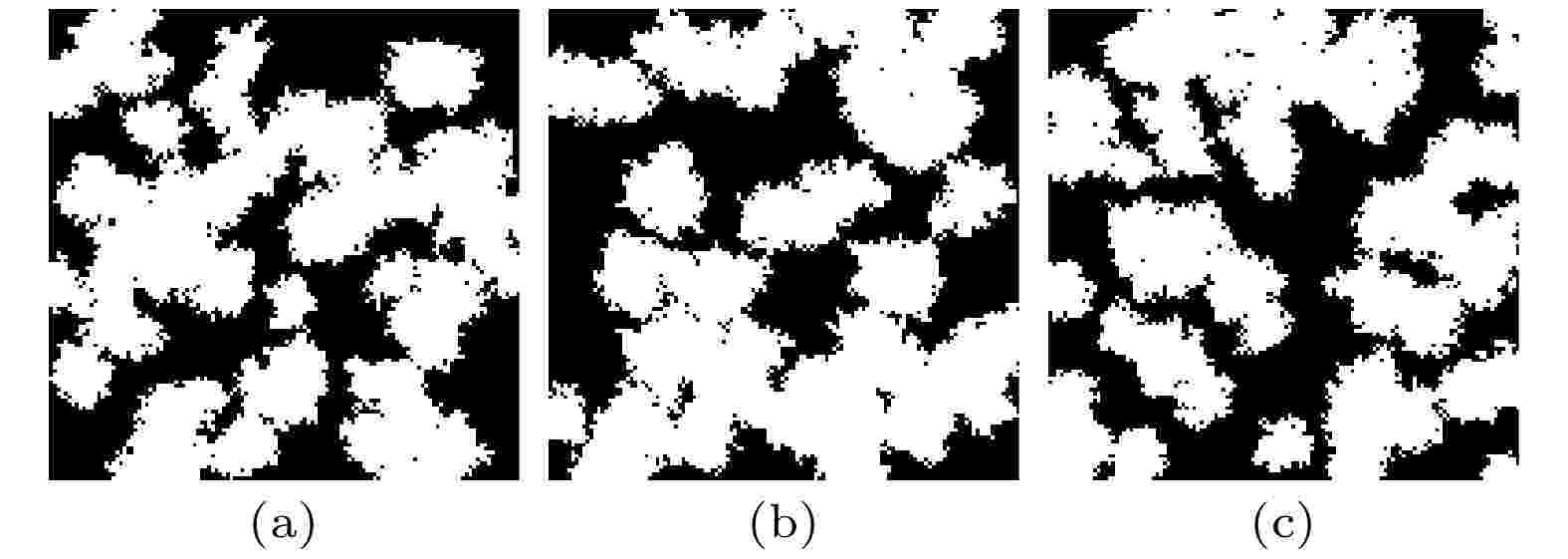
2021, 70 (5): 054401.
doi:10.7498/aps.70.20201061
Abstract +
Porous media are extensively used in the engineering field. The effective thermal conductivity and porosity are very important properties of porous medium materials. It is of great significance to obtain a porous medium material that meets the needs of effective thermal conductivity and porosity. In this paper, a four-parameter random generation method is used to produce a training data set, a conditional generation adversarial network (CGAN) is built, and a predetermined effective thermal conductivity and porosity are used as inputs to generate a porous medium structure that meets the input conditions. In particular, since the pore structure distribution of porous medium has a great influence on the effective thermal conductivity of the material, a local structure loss function is proposed to participate in the network training, so that the network can better learn the relationship between the pore distribution and the thermal conductivity. By using the lattice Boltzmann method to verify the effective thermal conductivity of the porous medium structure generated by the neural network, the results show that the method can quickly and accurately generate the porous medium structure with predetermined parameters.
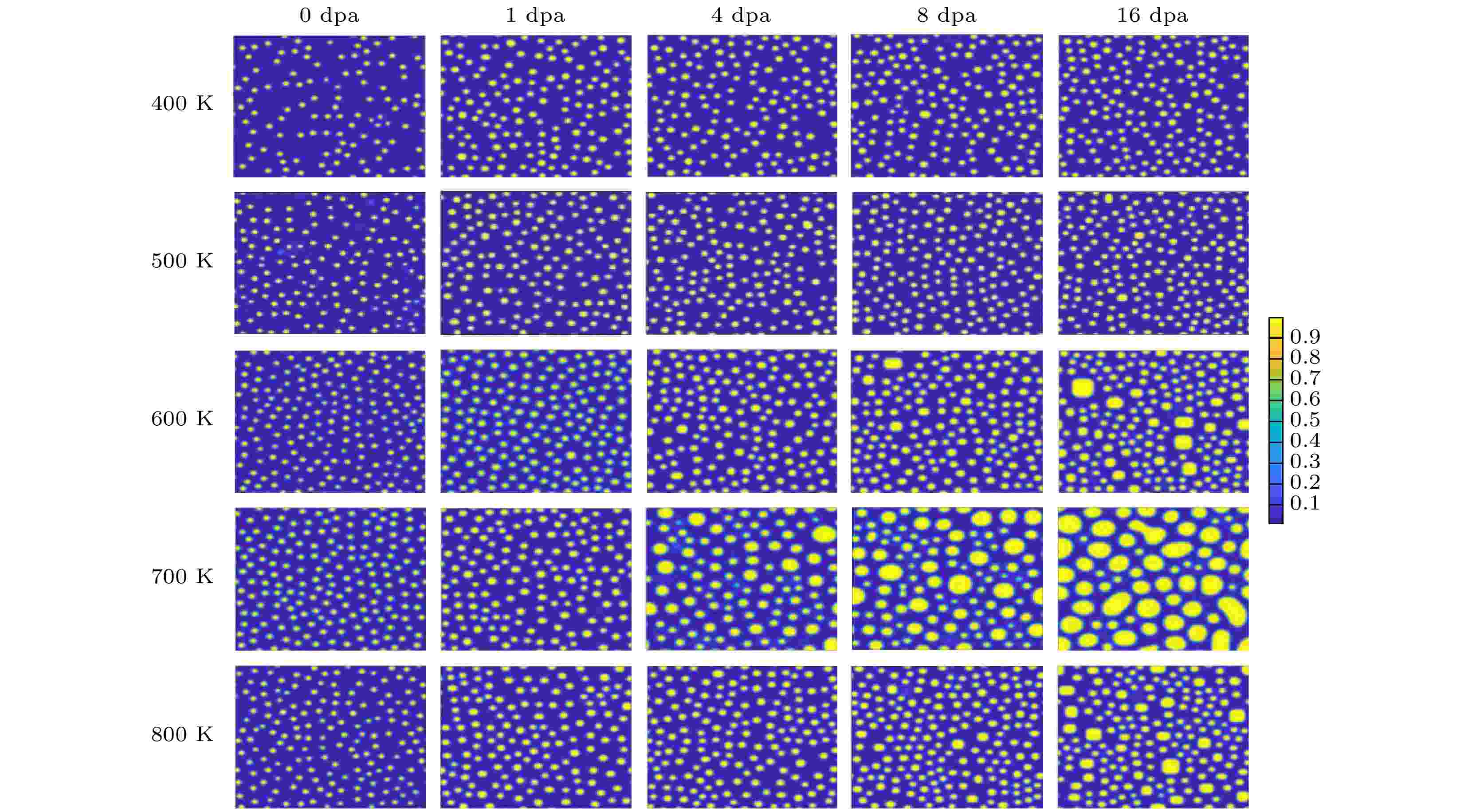
2021, 70 (5): 054601.
doi:10.7498/aps.70.20201457
Abstract +
As cladding materials, Fe-Cr alloys are used in the extreme environments of high temperature, high pressure, and energetic particle radiation, thus generating irradiation defects such as vacancies and interstitials. The clustering of irradiation defects leads the voids or dislocation loops to form, resulting in irradiation swelling and lattice distortion, and further radiation hardening or softening, finally, material failure. It is beneficial to tailor desired microstructures and obtain stable service performances by understanding defects cluster and voids formation process. In this paper, the phase-field method is employed to study the evolution of voids of Fe-Cr alloy. In the model the temperature effects on point defects and generation/recombination of vacancies and interstitials are taken into consideration. The 400–800 K temperature range and 0–16 dpa radiation dose range are selected, in which the voids’ formation process including generation and recombination, as well as vacancy clustering caused by vacancy diffusion, is studied for Fe-Cr alloy. The nucleation rate of the void cluster shows a trend of first increasing and then decreasing with temperature increasing from 400 to 800 K. This phenomenon is related to complex interactions among defects concentration, atomic diffusion, recombination, nucleation, and growth conditions. At a given temperature, the average radius and the volume fraction of the voids grow bigger as the radiation dose increases. With the increase of irradiation dose, the cascade collision reaction is strengthened, and the number of Frenkel defect pairs is also increases. A large number of vacancies and interstitial atoms are generated, and the rapid diffusion and accumulation of vacancies in the Fe-Cr alloy at high temperature form a larger number and larger size of voids. The incubation period of vacancy clusters and voids are quite different due to the influence of irradiation temperature and dose. The higher the irradiation dose, the shorter the incubation period is. The relationship between the incubation period and temperature is more complicated. When the temperature is relatively low, the incubation period is shortened as the temperature increases, and as the temperature continues to increase to a higher temperature, the incubation period is extended. This relates to the increase in the concentration of vacancies, the recombination of vacancies and interstitials, and the increase of the critical nucleus radius for the growth of voids when the temperature increases.
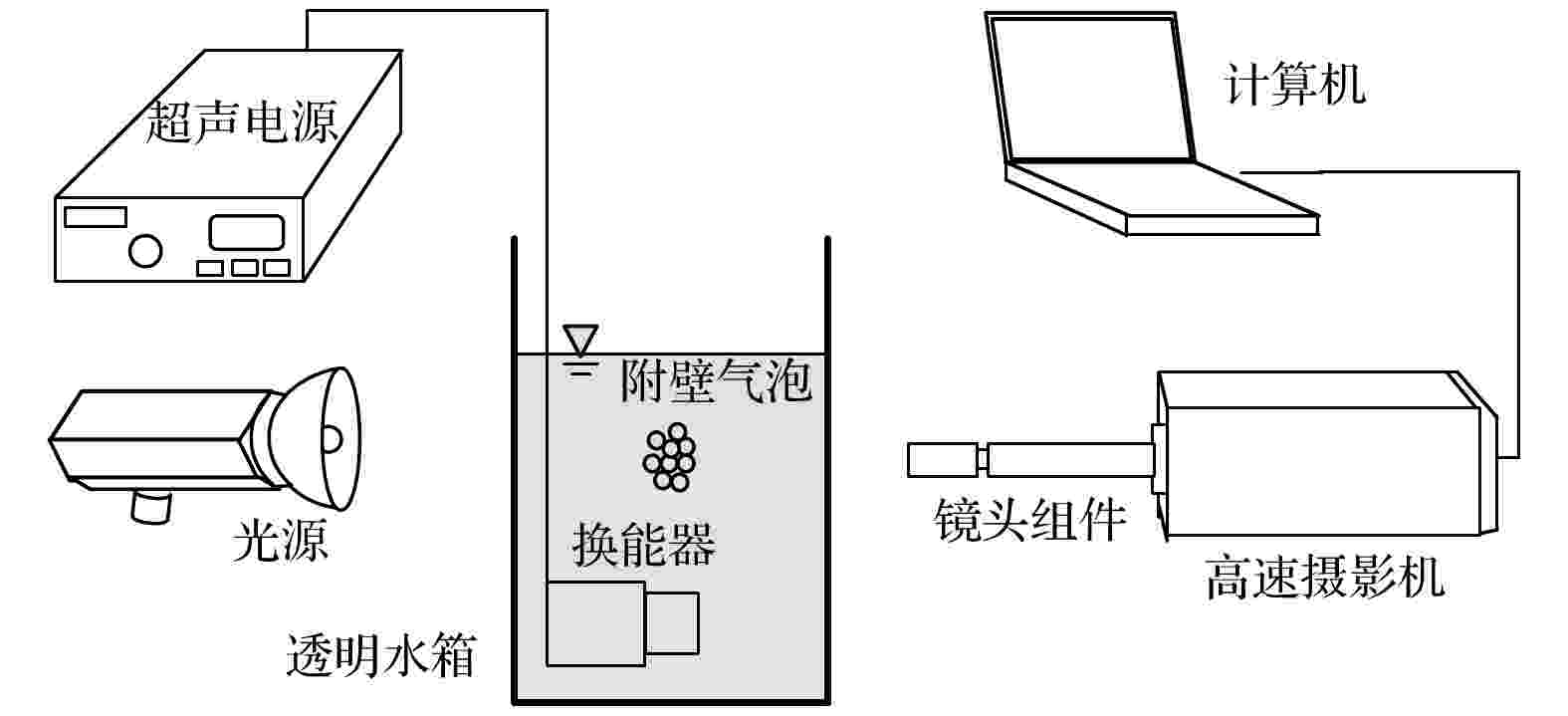
2021, 70 (5): 054701.
doi:10.7498/aps.70.20201381
Abstract +
Bubbles in the fluid have a great influence on the macroscopic physical properties and flow state of the fluid. The study of bubble motion in fluid is of great significance to ultrasonic cleaning, sonochemistry, flood discharge and energy dissipation, aeration and cavitation reduction. Bubbles in the fluid may also exhibit a special translational motion in an ultrasonic field—orbital motion. The orbital motions of gas bubbles attached to a boundary in ultrasonic field are investigated experimentally by high-speed photography and image analysis. The present study focuses on the trajectories of wandering bubbles, the arrangement of gas bubble array, the source of gas bubbles and the surface fluctuation details of gas bubbles. It is found that the circular trajectory of the wandering gas bubble is unstable, irregular and unsmooth. The holding gas bubbles in the bubble array originate from wandering bubbles. The transformation of wandering bubbles into array bubbles is mainly realized by merging and increasing the volume, thereby reducing the Bjerknes force. The wandering bubbles are produced by the merging of a large number of cavitation bubbles in the ALF (acoustic lichtenberg figure) structure, which makes the radial vibration bubbles gradually transform into the surface fluctuating bubbles. Under the action of Bjerknes force, the array bubbles show regular surface fluctuations, while the smaller ones are completely unstable, showing extremely irregular morphology, and have an influence on the surface fluctuation of nearby array bubbles. The array bubbles show a very regular arrangement, and the adjacent array bubbles have opposite vibration phases and repel each other. The orbital motion of gas bubbles attached to a boundary is significantly different from that of the bubbles suspended in liquid. First of all, the attached bubbles move along the solid wall, while the suspended bubbles move completely away from the vessel wall in the liquid. Secondly, the attached bubbles move around a regular array of bubbles, while the suspended bubbles move orbitally alone. In addition, the attached bubble is nearly hemispherical, and its surface fluctuates violently, and its motion track is extremely unsmooth, which is different from the circular motion of spherical suspended bubble. Finally, there is a strong interaction between the attached wandering bubble and the array bubble, which has a great influence on the vibration and trajectory of the attached bubble. In contrast, the circular motion of the suspended bubble does not have such a complex effect.

2021, 70 (5): 054702.
doi:10.7498/aps.70.20201384
Abstract +
In order to study the breakup process of liquid jet in gas film, the backlit photography technique and the VOF TO DPM method are used for experimental and simulation research respectively. Water and air are used as simulant media. Grid adaptive technology is used to refine the gas-liquid interface grid and improve the capture accuracy of the gas-liquid interface. The results show that there are two main breakup processes of liquid jet in gas film: column breakup and surface breakup. The local high-pressure zone in front of the liquid jet makes the jet have a large normal velocity gradient, which causes R-T instability. The surface wave that is generated by the R-T instability is mainly responsible for the liquid column breakup. When the thin liquid film reaches a column breakup point, the airflow penetrating the trough of the surface wave causes the jet column to break. The tangential velocity gradient is generated when the gas film bypasses the liquid jet surface, which causes K-H instability. The K-H surface waves cause ligaments and droplets to strip from the surface of the liquid jet. The local momentum ratio has an important influence on the breakup process of the liquid jet in gas film. When the local momentum ratio is low, the breakup of liquid jet is dominated by the K-H instability. As the local momentum ratio increases, the breakup of liquid jet is gradually dominated by R-T instability. The local momentum ratio plays an important role in the distribution range of the liquid jet in gas film. When the local momentum ratio is low, the ligaments and droplets caused by the liquid jet are mainly distributed within the range of gas film. As the local momentum ratio increases, part of the ligaments and droplets escape from the range of the gas film. The liquid jet penetrates the gas film when the local momentum ratio is greater than 0.74. The breakup length and the penetration depth are both affected by the local momentum ratio. The breakup length increases with the local momentum ratio increasing. The penetration depth also increases with the local momentum ratio, and the penetration depth increases significantly when the liquid jet penetrates the gas film.
PHYSICS OF GASES, PLASMAS, AND ELECTRIC DISCHARGES
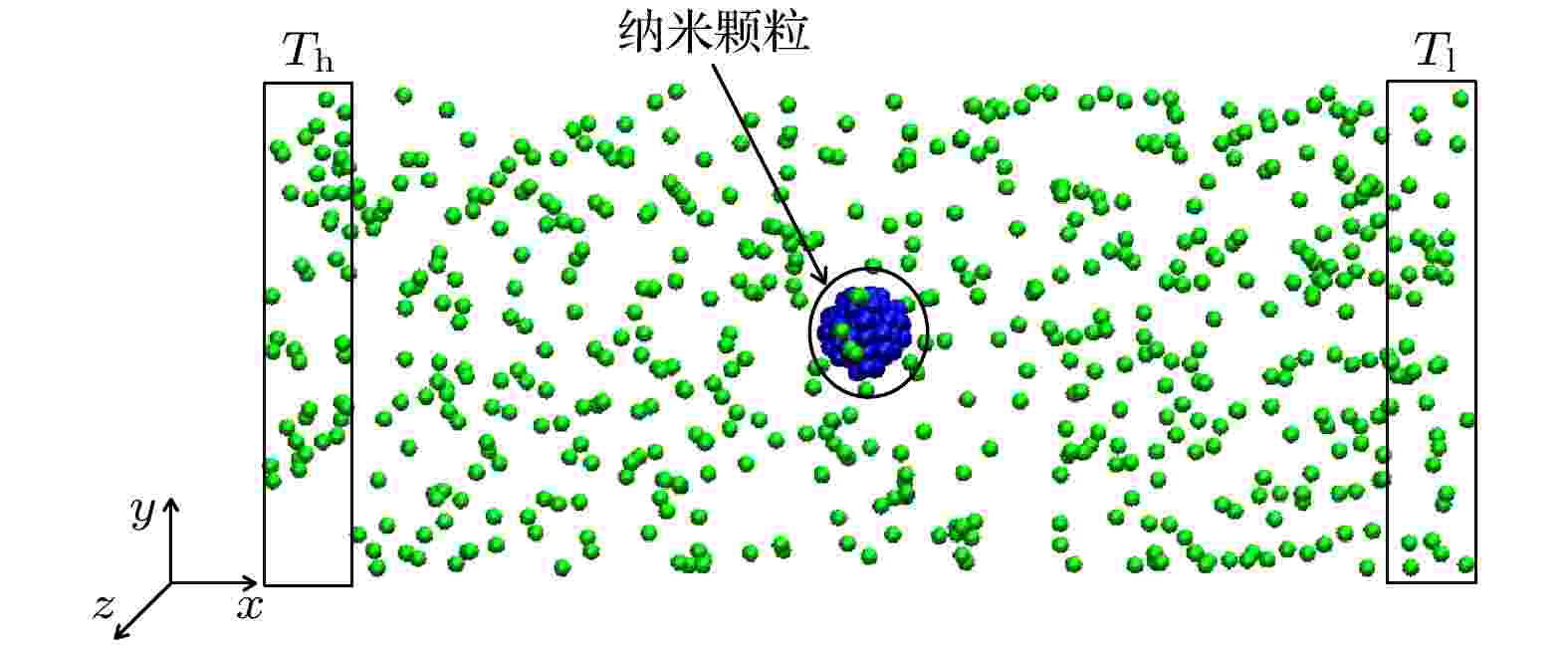
EDITOR'S SUGGESTION
2021, 70 (5): 055101.
doi:10.7498/aps.70.20201629
Abstract +
Thermophoresis refers to the motion of small particles suspending in a fluid with non-uniform temperature distribution due to the temperature gradient around the particle. Usually, the fluid molecules coming from the hot side carry more kinetic energy than those from the cold side, which results in a net thermophoretic force in the direction opposite to the temperature gradient. Since it was discovered more than 100 years ago, thermophoresis has been of major importance in a variety of applications, where it can play either beneficial role or adverse role, including material synthesis, micro- and nano-fabrication, and environmental science. Therefore, it is necessary to accurately evaluate the thermophoretic force. In the present work, the thermophoretic force on nanoparticles is examined in the free molecule regime by using non-equilibrium molecule dynamics (MD) simulation. It has been widely accepted that the thermophoretic force conforms with the Waldmann equation for large Knudsen numbers. However, due to the effect of the nonrigid-body interactions between the particle and gas molecules, the thermophoretic force on nanoparticles might deviate greatly from the classical theory. In our MD model, a single nanoparticle with a diameter of several nanometers suspends in a diluted gas. The Lennard-Jones (L-J) potential is employed to simulate the intermolecular interactions. To avoid deforming the nanoparticle, the solid molecules within the nanoparticles are linked to their nearest neighbors through a finite extensible nonlinear elastic bonding potential. The thermophoretic force on a nanoparticle is calculated by imposing a harmonic potential on the nanoparticle, which eliminates the effect of the Brownian motion of the nanoparticle on the thermophoresis. The effective thermal conductivity of the ambient gas is employed in Waldmann equation for the thermophoretic force due to the finite volume effect. It is found that the Waldmann theory for thermophoresis is still valid for nanoparticles in the case of weak gas-particle interaction or high gas temperature. With the increase of the gas-particle interaction strength or the decrease of the gas temperature, the Waldmann theory is invalid due to the effect of gas-particle nonrigid-body collisions and the adsorption of gas molecules on the particle surface. By considering the gas-particle nonrigid-body interaction and the modified particle size, the theoretical results for thermophoretic force accord with the MD simulations quite well.
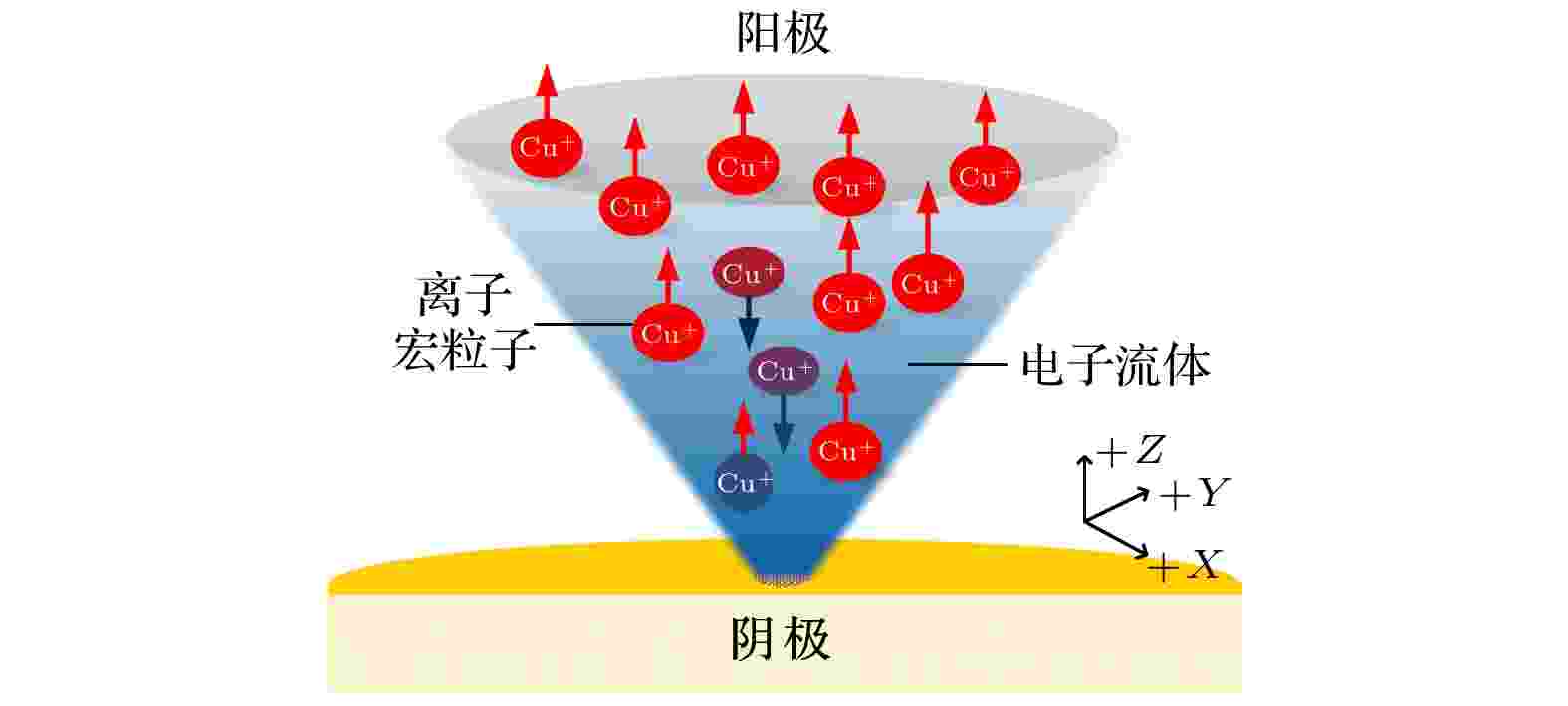
2021, 70 (5): 055201.
doi:10.7498/aps.70.20201701
Abstract +
Vacuum arc is a special metal vapor discharge phenomenon, because its discharge medium totally comes from the evaporation and ionization of electrode materials. In the case of low current, the vacuum arc is completely composed of plasma jets emitted from discrete cathode spots on the cathode surface and the current carried by each spot depends on the cathode material. When the arc current exceeds a certain value, a certain number of cathode spot plasma jets will appear. Vacuum arcs play a very important role in some industrial applications such as vacuum circuit breakers, vacuum coatings and electric thrusters. As an important plasma control method, the external axial magnetic field (AMF) has an important influence on the macroscopic morphology and microscopic parameter distribution of the vacuum arc. Various studies of vacuum arc under AMF have been carried out and some progress has been made. However, the existing literature about the simulation research of vacuum arc is mostly concentrated in the case of large current, and less attention is paid to the case of small current. The reason is that the traditional methods, magneto-hydrodynamics or particle-in-cell, are limited by either accuracy or efficiency, and cannot be effectively applied to the low current vacuum arc plasma jet simulations. In this paper, we develop a fully three-dimensional hybrid plasma simulation algorithm to study the single cathode spot vacuum arc plasma jet under AMF. In this model, ions are modelled as particles while electrons are treated as massless fluid, and the self-generated magnetic field is also considered. To simplify the condition, the cathode spot in our model only exists as a plasma jet source, thus the detailed mechanism of producing plasmas is neglected. And the movement of the cathode spot is not considered either. The results show that the single cathode spot plasma jet diffuses into the interelectrode in a cone shape after leaving the cathode spot, and the ion density drops rapidly from cathode to anode. Under the simulation conditions in this paper (I≤ 150 A), the self-generated magnetic field will not have a significant influence on the plasma jet itself in the case of low current. The external AMF has a compressive effect on the diffusion of the vacuum arc plasma jet. Under the AMF, the radial movement of the ions is suppressed, and the decrease of the ion radial velocity leads to a smaller diffusion radius of the jet. This compression effect of the AMF on the plasma jet is related to both the intensity of the external AMF and the magnitude of the arc current. In the case of a constant arc current magnitude, the compression effect gradually increases as the value of the AMF intensity gradually increases; in the case of a constant value of the external AMF, the compression effect gradually decreases as the current gradually becomes larger.
CONDENSED MATTER: STRUCTURAL, MECHANICAL, AND THERMAL PROPERTIES
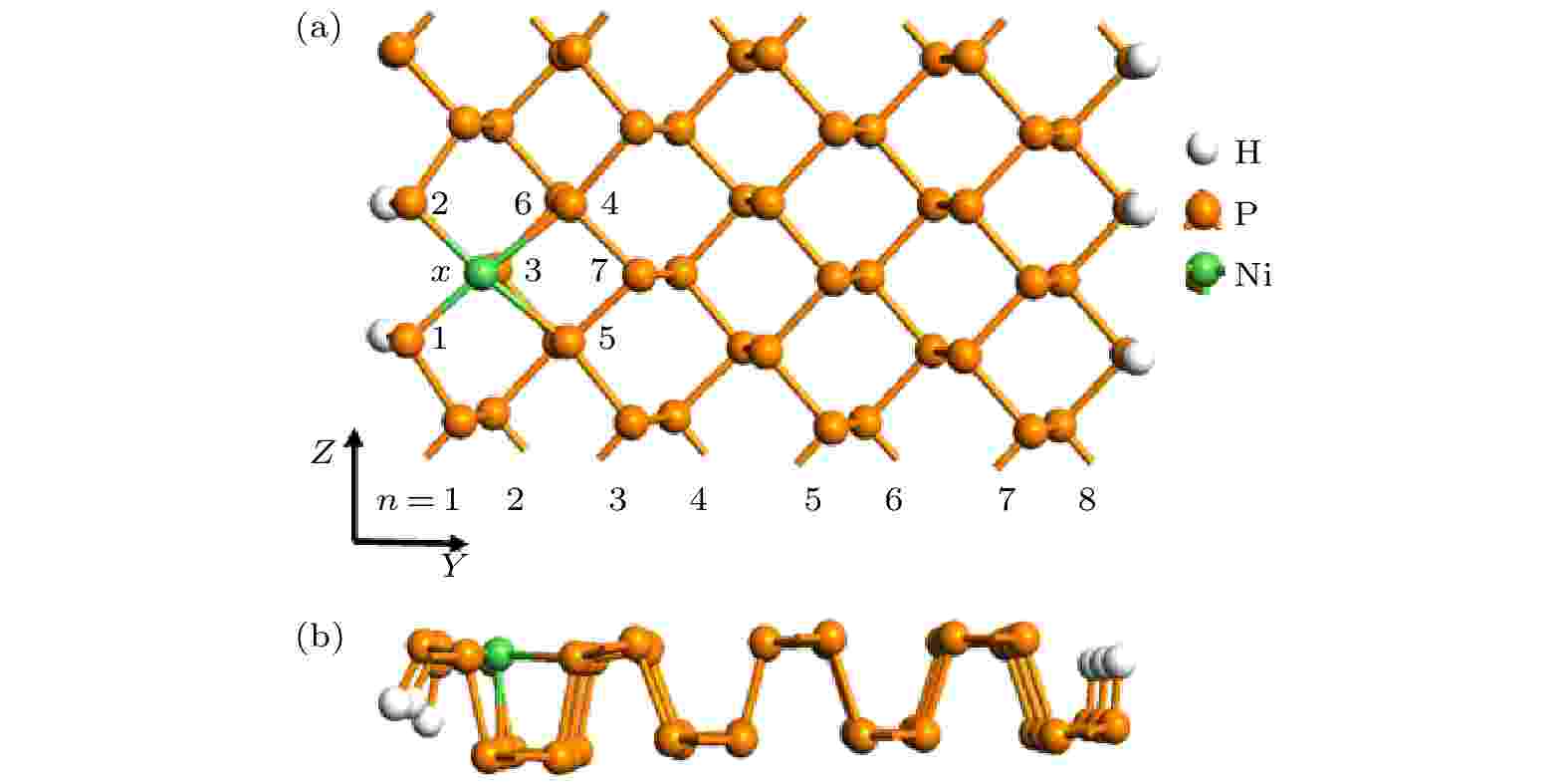
2021, 70 (5): 056101.
doi:10.7498/aps.70.20201408
Abstract +
The magneto-electronic properties of zigzag phosphorene nanoribbons (ZPNRs) doped, respectively, with iron (Fe), cobalt (Co) and nickel (Ni) atoms are investigated by the first-principles method based on density functional theory. The calculated results show that the structures of doped and undoped ZPNR are stable because their binding energy and Gibbs free energy are negative, and the Forcite annealing dynamics simulation shows that the thermal stabilities of all doped ZPNRs are extremely high. The ground states of pristine ZPNRs and ZPNRs doped with Co atoms are nonmagnetic states, while the ground states of ZPNRs doped with Fe or Ni atoms are ferromagnetic states. When they are in the nonmagnetic states, the pristine ZPNRs and ZPNRs doped with Co atoms turn into semiconductors, while the ZPNRs doped with Fe or Ni atoms become metals. The undoped ZPNRs are direct band gap semiconductors, while the ZPNRs doped with Co atoms are indirect band gap semiconductors, and the band gaps of the latter are smaller than those of the former. The changes of the properties of the ZPNRs are due to the introduction of impurity energy band into the energy band structures. The spin-polarized calculation displays that the pristine ZPNRs and ZPNRs doped with Co atoms are non-magnetic, and the ZPNRs doped with Fe or Ni atoms are magnetic but only in the ferromagnetic state. In the ferromagnetic state, the ZPNRs doped with Fe atoms are spin semiconductors, while the ZPNR doped with Ni atoms are spin half-metals. This means that the half-metal feature can be realized by doping Ni atom into ZPNR. The magnetism of ZPNRs doped with Fe or Ni atoms is mainly contributed by impurity atoms, and the occurrence of magnetism is due to the existence of unpaired electrons in ZPNR. The doping position has a certain influence on the electromagnetic properties of ZPNR. In the ferromagnetic state, the ZPNRs are half-metals when the Ni atoms are doped near the edge of the nanoribbons, while the ZPNRs are spin semiconductors as the Ni atoms are doped near the symmetric center of the nanoribbons. These results might be of significance for developing the phosphorene based electronic nanodevices
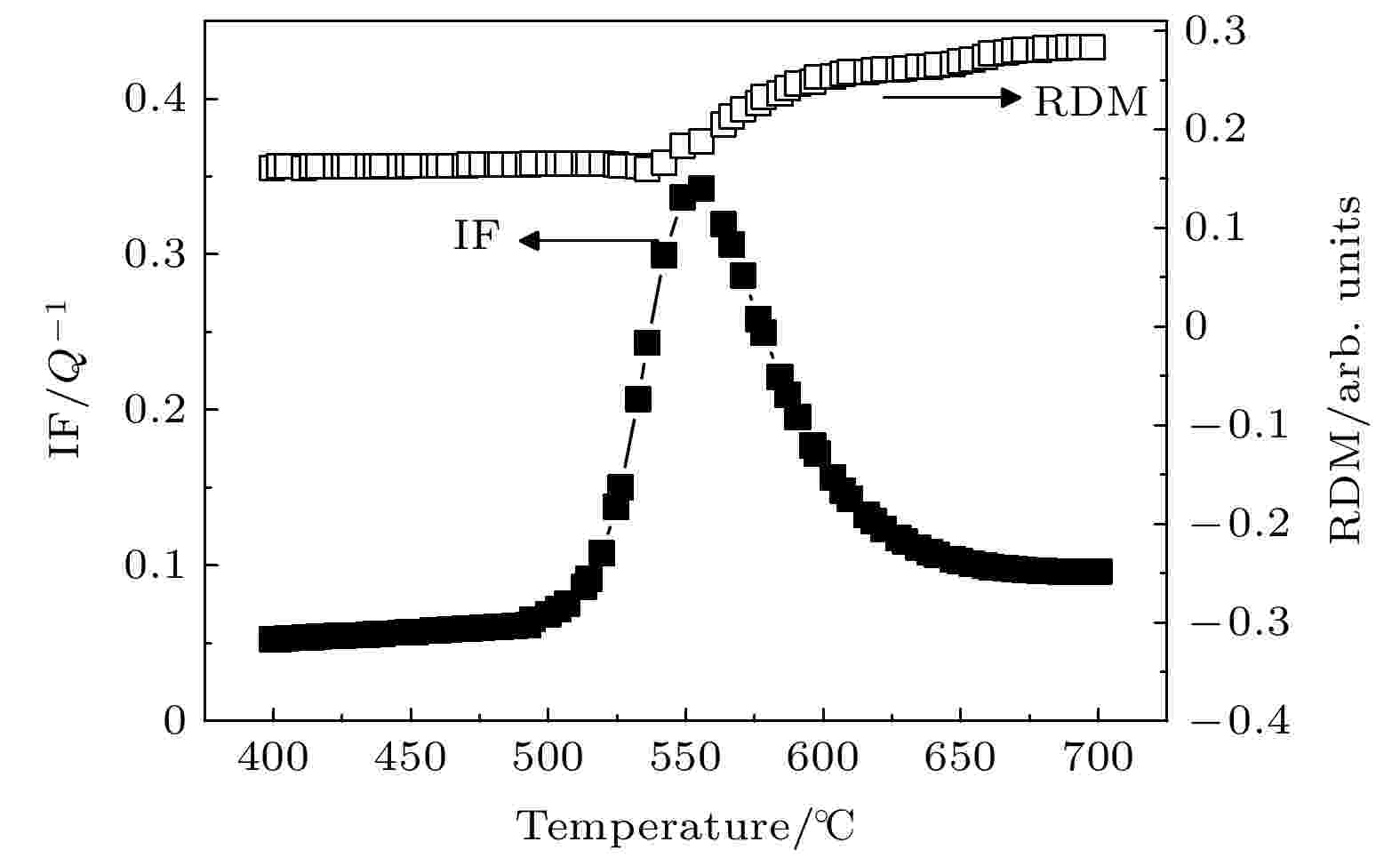
2021, 70 (5): 056102.
doi:10.7498/aps.70.20201422
Abstract +
The Ni-Al intermetallic compounds, as important high-temperature structural materials, have clear target requirements in a number of fields. Powder metallurgy is an important candidate for preparing the Ni-Al intermetallic compounds. Clarifying the formation and transformation process of Ni-Al intermetallic compounds in sintering process and determining the solid diffusion reaction temperature and types of intermetallic compounds are greatly important for tailoring sintering process and optimizing product quality. In this paper, the internal friction behaviors of Ni-Al powder mixture compacts in the sintering process are systematically investigated by the internal friction technique. A typical internal friction peak is observed in the internal friction-temperature spectrum. The peak height decreases with the measuring frequency increasing, but the peak temperature is independent of frequency. Moreover, the internal friction peak shifts toward higher temperature and the peak height increases as the heating rate increases. It is reasonable that the internal friction peak belongs to the typical phase transformation internal friction peak which is associated with the formation of intermetallic compounds NiAl3and Ni2Al3in the heating process. Furthermore, the microstructure of the Ni-Al powder mixture can be tailored by mechanical ball-milling. The internal friction peak shifts toward lower temperature and the peak height decreases with the ball-milling time increasing, which indicates that the solid diffusion reaction can be activated at lower temperature with a slower reaction rate. This decrease is related to the refinement of powder particles, the lamellar formation of powder mixture, the enhancement of solid solution degree and surface energy, and the shortened atomic diffusion distance due to the mechanical ball-milling. It is also indicated that the mechanical ball-milling can effectively reduce the initial temperature of solid diffusion reaction, thus lowering sintering temperature.
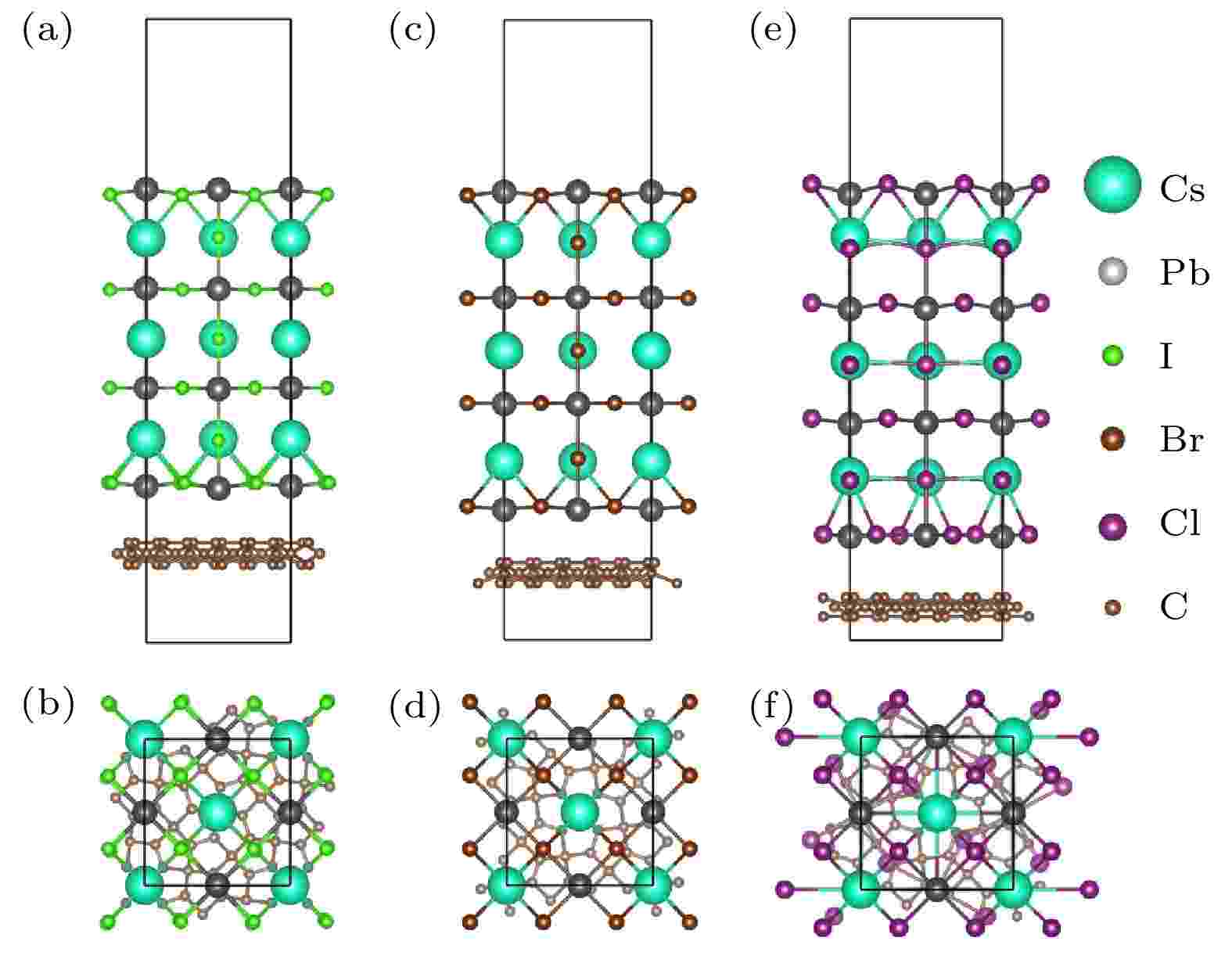
2021, 70 (5): 056301.
doi:10.7498/aps.70.20201246
Abstract +
Heterostructure engineering is an effective strategy to improve the optoelectronic properties of semiconductor materials. We propose a van der Waals (vdW) heterostructure based on perovskite CsPbX3(X= Cl, Br, I) and two-dimensional penta-graphene (PG), and investigate the stabilities of two kinds of interface contacts (Pb-Xand Cs-X) by first-principles calculations. And we also study the electronic structures and optoelectronic properties of CsPbX3-PG heterostructures with stabler Pb-Xinterface. Our results show that all the CsPbX3(X= Cl, Br, I)-PG heterostructures possess the type-II band arrangement, that the energy level gap is gradually narrowed from Cl to I, and that there are good photogenerated carrier separation ability and charge transport property. Moreover, the absorption spectrum of CsPbX3-PG heterostructures can be broadened and the optical absorption ability is effectively improved. The power conversion efficiency (PCE) of CsPbX3-PG can increase up to 21% given by theoretical estimation. These results indicate that the optoelectronic properties of the all-inorganic metal halide perovskite CsPbX3-PG heterostructures can be effectively improved, which would become a potential candidate for high-performance photoelectric conversion devices.s.
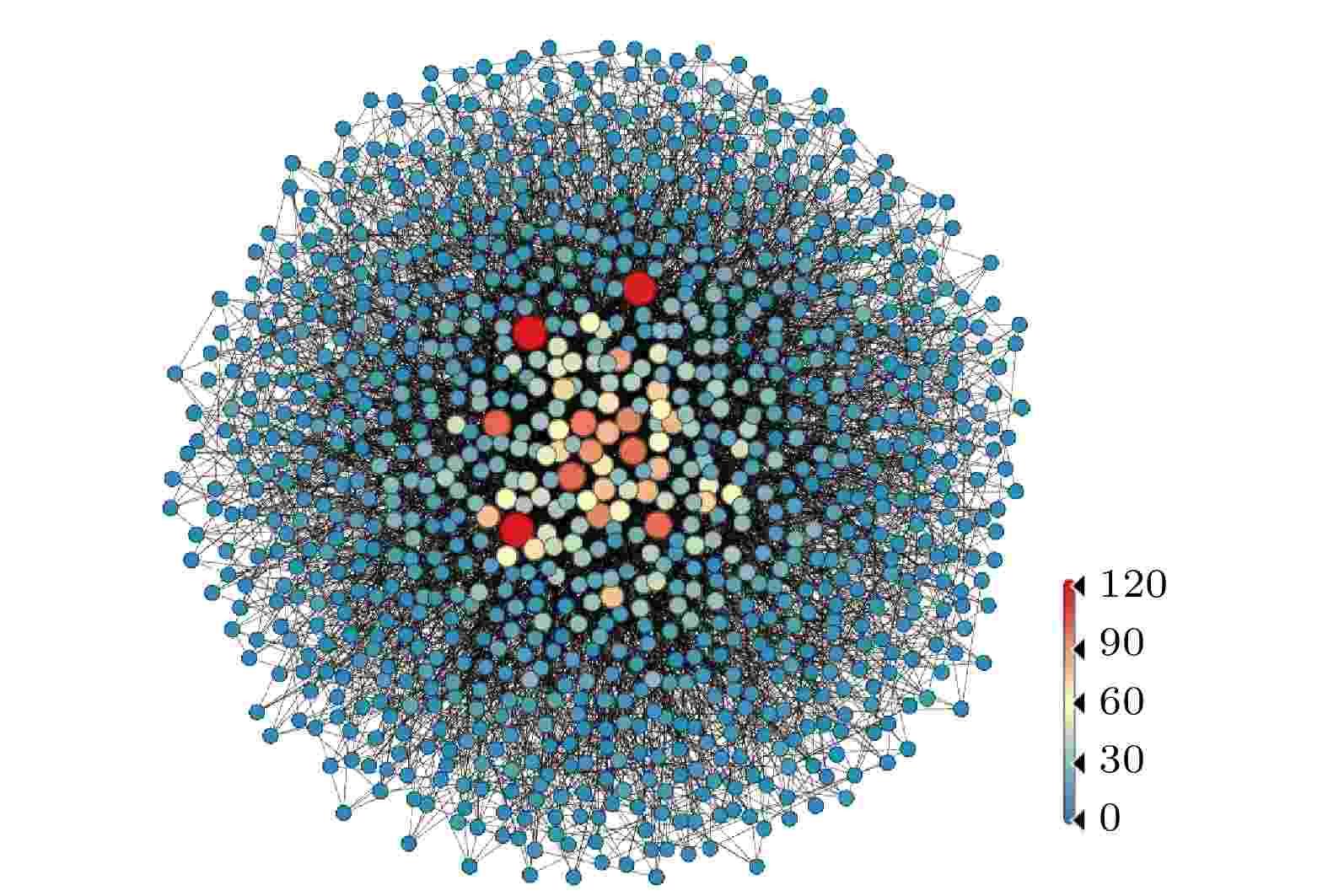
2021, 70 (5): 056401.
doi:10.7498/aps.70.20200872
Abstract +
Controlling a complex network to achieve a certain desired objective is an important task for various interacting systems. In many practical situations, it is expensive and unrealistic to control all nodes especially in a large-scale complex network. In order to reduce control cost, one turns to control a small part of nodes in the network, which is called pinning control. This research direction has been widely concerned and much representative progress has been achieved so far. However, to achieve an optimal performance, two key questions about the node-selection scheme remain open. One is how many nodes need controlling and the other is which nodes the controllers should be applied to. It has been revealed in our recent work that the effectiveness of node-selection scheme can be evaluated by the smallest eigenvalue
$ {\rm{\lambda }}_{1} $
of the grounded Laplacian matrix obtained by deleting the rows and columns corresponding to the pinned nodes from the Laplacian matrix of the network. As a further study of our previous work, we study node selection algorithm for optimizing pinning control in depth, based on the proposed index
$ {\rm{\lambda }}_{1} $
and its spectral properties. As is well known, it is an NP-hard problem to obtain the maximum of
$ {\rm{\lambda }}_{1} $
by numerical calculations when the number of pinned nodes is given. To solve this challenge problem, in this paper a filtering algorithm is proposed to find most important nodes, which results in an optimal
$ {\rm{\lambda }}_{1} $
when the number of pinned nodes is given. The method can be applied to any type of undirected networks. Furthermore, in this paper we propose the concept of node-set importance in complex networks from the perspective of network control, which is different from the existing definitions about node importance of complex networks: The importance of a node set and the selected nodes in this paper depends on the number of pinned nodes; if the number of pinned nodes is different, the selected nodes will be different. The concept of node-set importance reflects the effect of nodes’ combination in a network. It is expected that the obtained results are helpful in guiding the optimal control problems in practical networks.
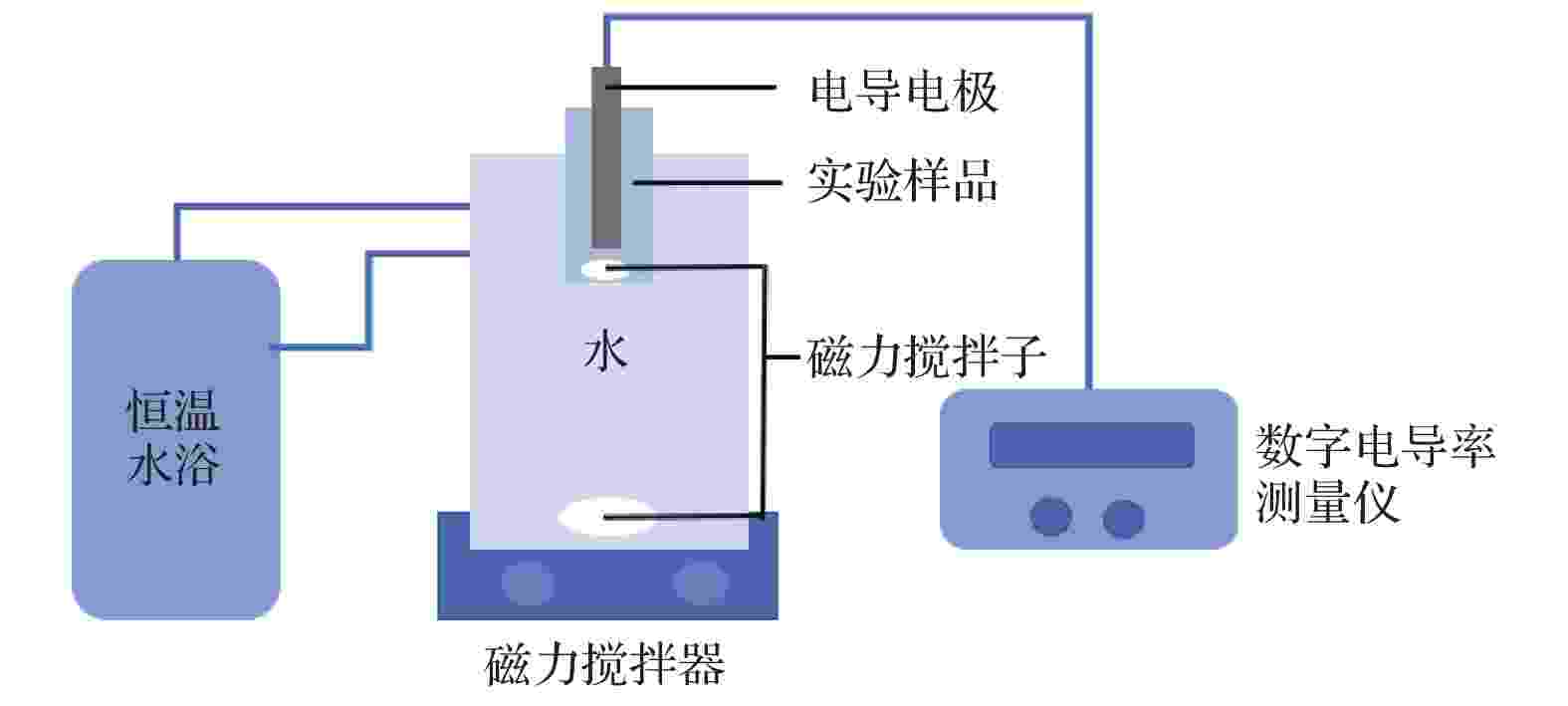
2021, 70 (5): 056402.
doi:10.7498/aps.70.20201472
Abstract +
The effective surface charge of colloid particles is an important parameter that determines the colloidal properties. However, it is still unclear whether the solvent environment (such as the electrolyte concentration) can affect the effective surface charge. Due to complicated effects relevant to the effective surface charge, such as the exchange of dissociable ions between the electrolyte and surface groups of polystyrene particles, the coupling effect of incomplete ionization of the surface groups of the particles and the adsorption of ions by colloidal particles, etc., it is rather difficult to accurately measure the surface charge and understand the mechanism of charge variation with solvent environment. To solve this problem, we measure the conductivities of polystyrene colloidal particles of carboxyl groups and sulfonic acid groups at various particle number densities and HCl concentrations. Since the cations generated from the two kinds of particles and HCl solution are all H+cations, the surface charge can be obtained by the conductivity-number density method (migrant method), no matter whether the cation exchanges occur between ionized positive ions of the electrolyte and colloidal particles. Based on the experimental results, the influences of HCl concentration and particle number density on the surface charge of colloidal particles are detected, and the reasons of the influence are analyzed. It is found that the change of the surface charge of the particles of carboxyl group with HCl concentration is faster than that of sulfonic acid group with the HCl concentration. For the same electrolyte concentration, the effective surface charge of carboxyl modified colloidal particles is related to the particle number density, while the charge of sulfonic modified particles is not. Considering the fact that the sulfonic acid group and carboxyl group are strong and weak acid groups respectively, the ionization of H+cations of the two different groups have profound influences on the cation replacement process, and affect the trend of the curve of the conductivity-particle number density. This effect further results in different change tendencies of effective surface charge with HCl concentration and particle number density. According to the theoretical model as described in this study, all experimental results are well explained. The mechanisms described in this article will be useful for stating the influencing factors of the surface effective charge, and the application of the effective charge to different phenomena relating to interparticle interactions with different parameters of solutions.
CONDENSED MATTER: ELECTRONIC STRUCTURE, ELECTRICAL, MAGNETIC, AND OPTICAL PROPERTIES
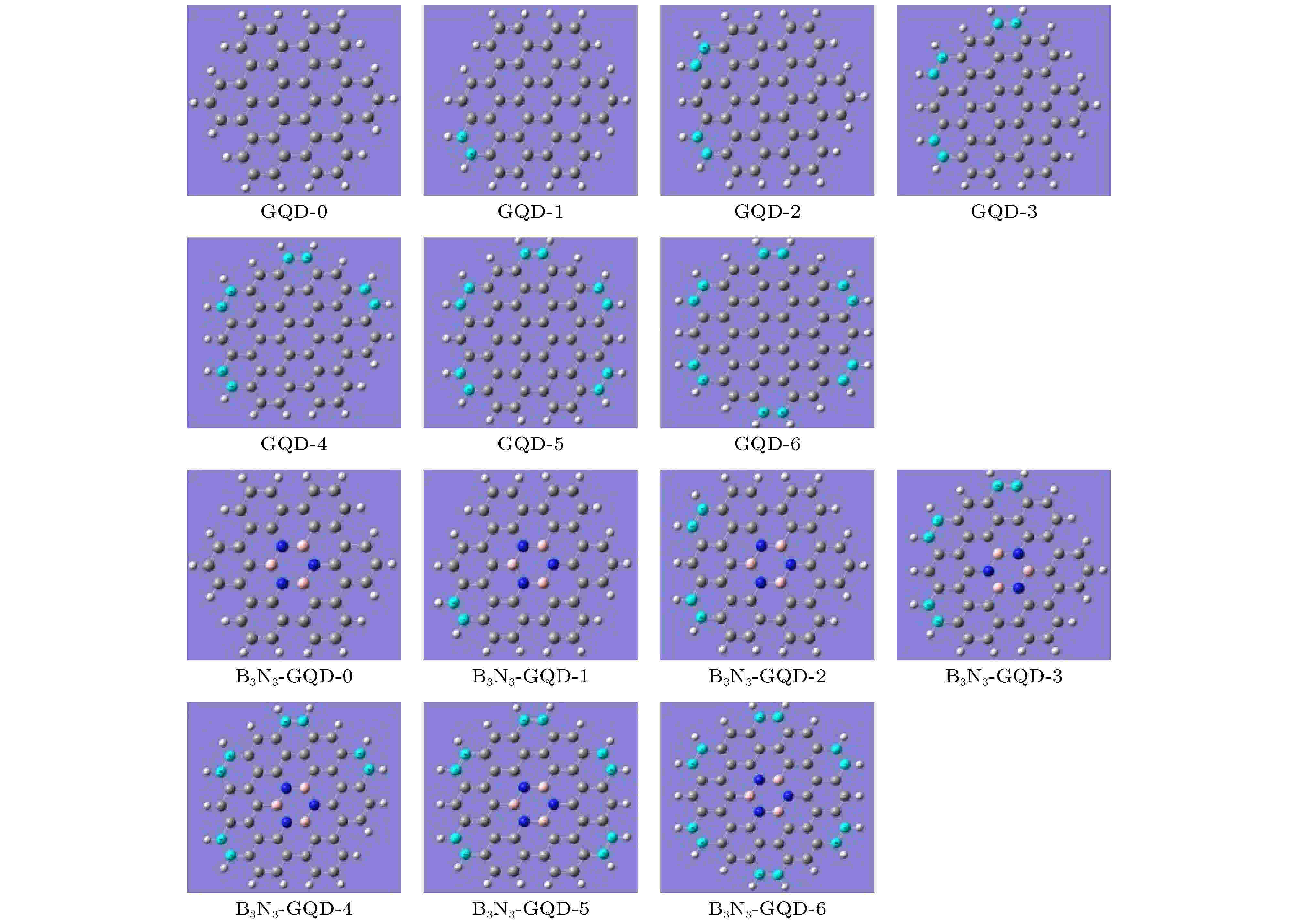
2021, 70 (5): 057801.
doi:10.7498/aps.70.20201643
Abstract +
Graphene is a two-dimensional material with single-layer honeycomb lattice structure formed by sp2hybrid connection of carbon atoms. Graphene has excellent optical, electrical, thermal and mechanical properties, and it is considered to be an ideal material for future flexible optoelectronic devices. In recent years, the nonlinear optical properties and regulation of graphene nanostructures have attracted experimental and theoretical interest. Graphene has good delocalization of π-electrons and its unique plane structure, showing good nonlinear optical properties. Graphene quantum dots can be regarded as small graphene nanoflakes. Their unique electronic structure is closely related to the non-bond orbitals on the boundary/edge. Therefore, it is very important to study the boundary/edge effect on the electronic and optical properties of nanographene. In this paper, effects of the number of edge C=C double bonds and Borazine (B3N3) doping on the nonlinear optical properties and UV-Vis absorption spectrum of graphene quantum dots are studied by the quantum chemical calculation methods, respectively. It is found that the symmetry of hexagonal graphene quantum dots decreases and the symmetry of charge distribution is broken when C=C double bond is introduced into the armchair edge, which leads the second-order nonlinear optical activity to be enhanced. During the transition from armchair to zigzag edge, the polarizability and the second hyperpolarizability of hexagonal graphene quantum dots and B3N3-doped graphene quantum dots increase linearly with the number of introduced C=C double bonds incrrasing. In addition, the edge also has an important influence on the absorption spectrum of graphene quantum dots. For graphene quantum dots and B3N3-doped graphene quantum dots, the introduction of C=C double bond at the armchair edge increases the highest occupied molecular orbital energy level and also reduces the lowest unoccupied molecular orbital energy level, which reduces the energy gap between the frontier molecular orbitals, and thus resulting in the red-shift of the maximum absorption wavelength. The doping of B3N3ring will increase the energy gap between molecular frontier orbitals of graphene quantum dots, leading the UV-Vis absorption spectrum of graphene quantum dots to be blue-shifted. This study provides theoretical guidance for controlling the nonlinear optical response of graphene quantum dots by edge modification.
INTERDISCIPLINARY PHYSICS AND RELATED AREAS OF SCIENCE AND TECHNOLOGY
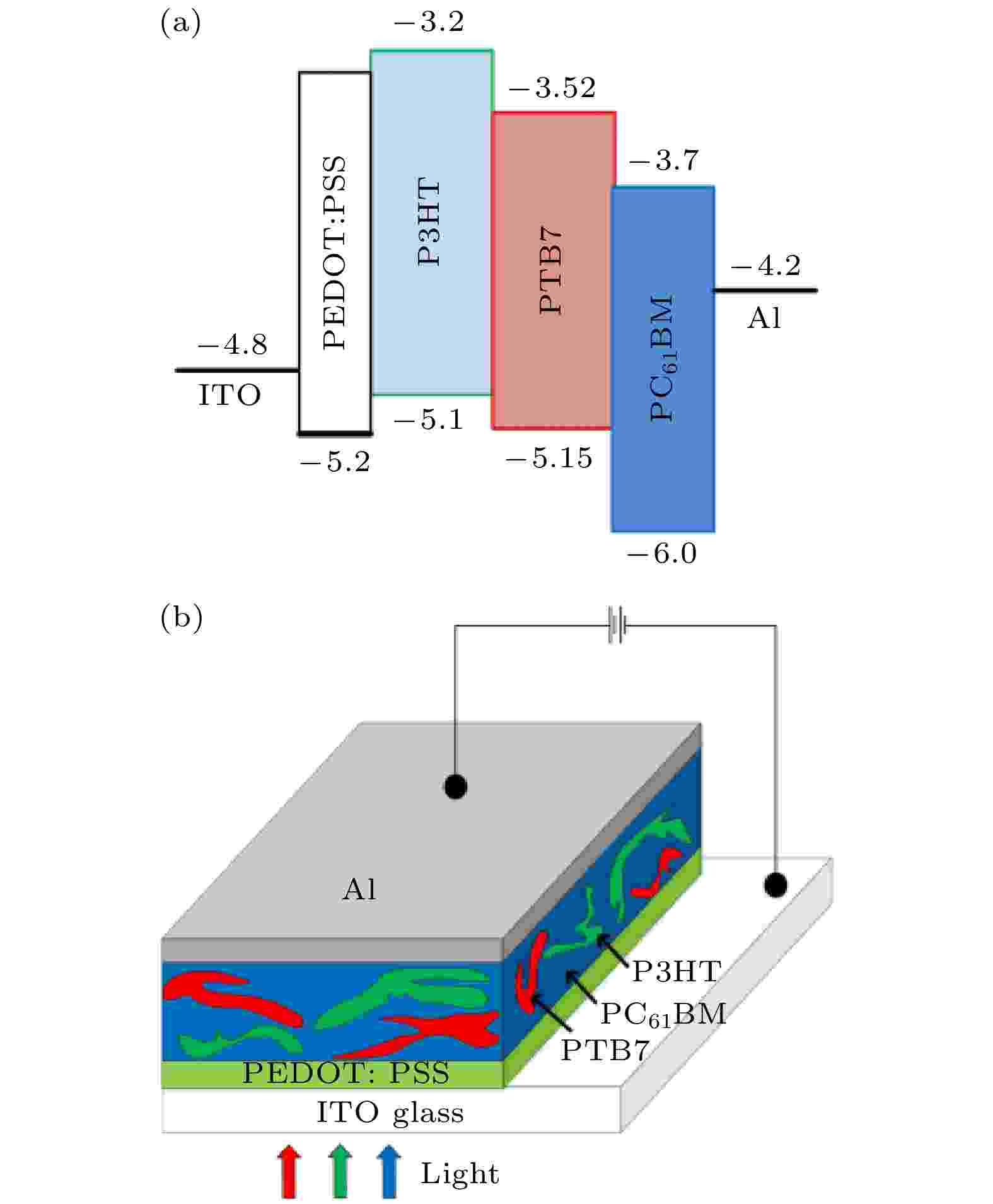
2021, 70 (5): 058801.
doi:10.7498/aps.70.20201185
Abstract +
In this paper, P3HT∶PTB7∶PC61BM is used as an active layer to prepare a ternary heterojunction organic photodetector covering the visible light range. The effects of PTB7 added to P3HT∶PC61BM system on the optical and electrical properties of organic photodetectors (OPDs) are studied by atomic force microscopy, ultraviolet-visible absorption spectroscopy and fluorescence spectroscopy. It is found that when the mass ratio of P3HT∶PTB7∶PC61BM is 8∶2∶10, the response spectrum of the ternary mixed layer extends to 780 nm, and the responsivity (R) of OPDs reaches 178, 291, and 241 mA/W respectively under 630, 530, and 460 nm light and –1 V bias, and the specific detection rate (D*) reaches 1012Jones, and the above results are compared with the research group’s previous results about P3HT∶PBDT-TT-C∶PC61BM as the active layer of ternary organic photodetector. The phenomenon of the device performance gap caused by adding two polymers PTB7 and PBDT-TT-C based on benzo[1, 2-b∶4, 5-b]dithiophene (BDT) units into the same system P3HT∶PC61BM is analyzed. The effect of PTB7 on the micro-morphology of the mixed film due to the introduction of fluorine atoms and the reason for the increase in the mobility of photogenerated carriers in the film are explained. This OPD with better preparation performance provides a theoretical basis and method.















